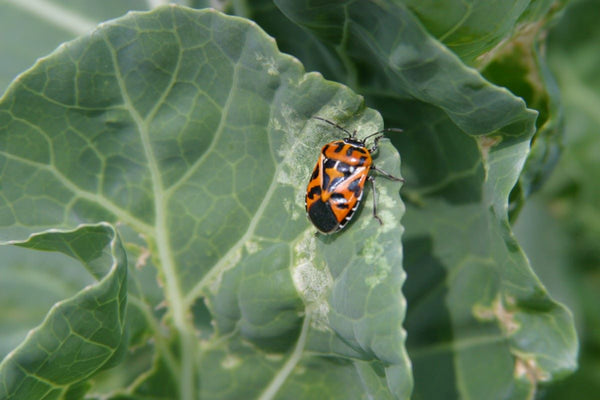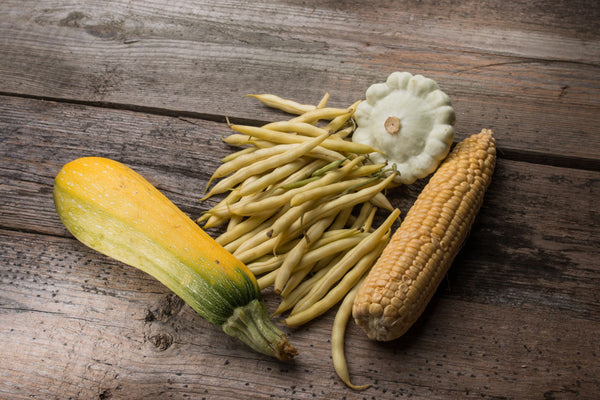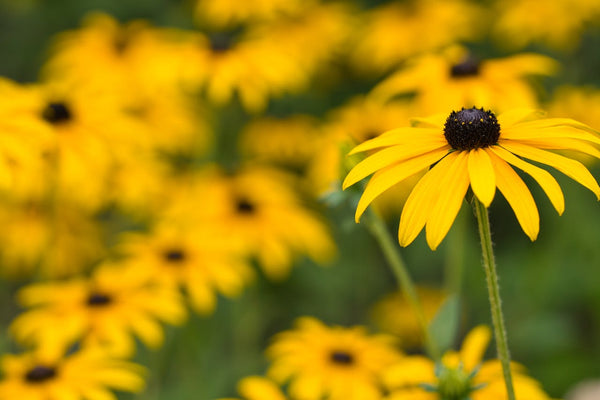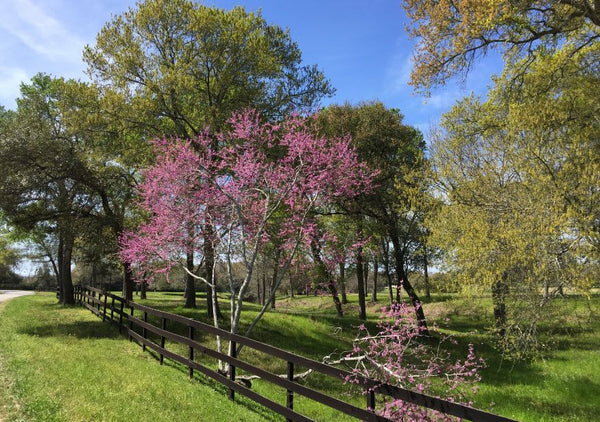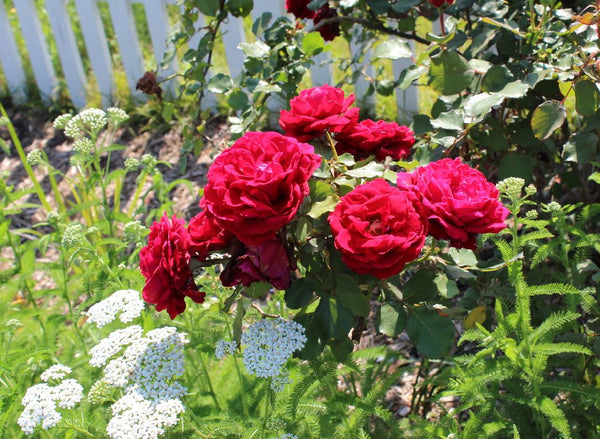By Skip Richter, Contributing Editor
Vegetables and herbs
If you are not a gardener in April, you are not a gardener! This is the prime month for spring gardening and the weather is mild, making it great to be outdoors.
Many cool-season vegetables are still producing, while the warm-season vegetables are growing fast on their way to next month’s harvest season.
Broccoli will produce side shoots after the central head is removed, so keep maintaining the plants as long as you can. Some cultivars are better at this secondary harvest than others.
Harlequin Bug
Harlequin bugs are not easy to control with sprays, so many gardeners consider this the sign that it is time to replace impacted plants with another crop
At some point the harlequin bugs may arrive en masse to your broccoli and other cole crops. They are not particularly easy to control with sprays, so many gardeners consider this the sign that it is time to replace these plants with another crop.
Keep harvesting cool-season greens as long as you can. Some, such as lettuce and spinach, start bolting with the arrival of longer days, which put an end to their productivity. Swiss chard is more tolerant of warm weather and can still be seeded out into the garden this month.
If you live in the northern parts of the state, you can get in a late tomato planting this month. Use large plants and quick-maturing cultivars, but don’t delay or else hot weather will arrive before the plants have set a good crop.
Three Sisters: Corn, beans and squash
This month is a good time to plant green beans (bush and pole), squash (summer and winter), cucumbers, corn, watermelons, cantaloupe (and other muskmelons), peppers and eggplant. It is also warming up enough for warm-season greens, southern peas and okra in the southern parts of the state.
After vegetables you have planted by seed have germinated, thin the stand to a proper spacing. Crowded seedlings develop slowly and may not produce well. Seed packets often provide suggested spacing, or you can find it in the Easy Gardening Series of publications on aggie-horticulture.tamu.edu .
Now that the soil is warming up, it is advisable to apply a layer of mulch over bare-soil areas in the garden. If weeds are still quite small, the mulch will smother and kill most species, but if they are getting larger, you may need to either hoe or hand-pull them prior to mulching.
Warmer weather means some pests are now out and about in the garden. Watch for early signs of caterpillars, beetles, leaf and flea beetles, aphids, stink bugs and leaf-footed bugs. The earlier you catch a pest or disease outbreak, the greater your options for managing it with less toxic products and the better your chance for getting it under control before significant damage is done.
Perennials and annuals
Black eyed susan
Continue planting the warm-season flowers mentioned in March . Now that the temperature is rising, impatiens, caladiums, pentas, purslane, Madagascar periwinkles and celosia can also be added to the list.
Near the end of the month, red bird of paradise ( Caesalpinia pulcherrima ) will consider it warm enough to be included in your plantings.
Warm-season vines such as morning glory, black-eyed Susan vine, cypress vine, blue sky vine ( Thunbergia grandiflora ), butterfly pea ( Clitoria ternatea ) and Mexican flame vine can provide cover for a fence or trellis to create a beautiful outdoor wall in the landscape. Consider adding an annual vine this year.
There are many great perennial flowers to include in the landscape for beauty that returns year after year. Salvias are a great genus with many wonderful species and cultivars to offer. For an added bonus, some are attractive to hummingbirds!
Fertilize your warm-season color beds monthly to maintain vigor and repeat blooming. Control weeds while they are still young and easy to remove. Mulch any bare-soil areas to minimize weed invasions.
Watch for pests and diseases, as mentioned in the vegetable section above. Spider mites will start showing up as the weather heats up. Both mites and aphids can be managed with insecticidal-soap sprays directed upward from beneath the foliage.
When the foliage of winter and spring bulbs starts to yellow and die back, remove it as it has done its job. These naturalizing bulbs will be moving into a dormancy period for summer as they await the arrival of cool weather next fall.
Trees, shrubs and vines
Redbud tree in bloom
When trees, shrubs and vines that bloom only in the spring complete their bloom cycle, it is time to do any needed trimming to train or shape the plants.
Examples of such woody ornamentals include spirea, flowering quince, azalea, camelia, pieris, dogwood, redbud, fringe tree, Texas mountain laurel, ornamental peach and plum, deciduous magnolias, mock orange and roses that only bloom once in the spring season.
For most of these plants, little pruning is needed, except to remove some gangly shoots sticking “out of bounds.” Established flowering trees need little pruning, but during the training stage pruning helps develop the general form and structure of the plant.
After new woody ornamentals have been growing for about six weeks, it is time to apply a light application of a turf-type fertilizer ( not a weed-and-feed). A good rule of thumb is to apply 1–2 cups (2–4 cups for organic products) per inch of trunk diameter evenly throughout a large circular area around the plant. Then rake it into the soil surface and water the area well.
Keep an eye out for bagworms on junipers and arborvitae. These pests can defoliate sections of a plant rapidly and, once the plant’s scale-like needles are lost, that area of the plant is not able to send out new green growth to replace it. If you see bagworms, a combination of snipping out the bags and periodically spraying the plant with an insecticide such as Bt (Bacillus thuringiensis) , spinosad or a synthetic product can help shut them down.
Crimson glory roses
This is the month where roses put on one of their best shows of the year. That makes it a good time to find varieties that appeal to you in neighbors’ yards or at a botanical garden. You can still plant container-grown roses if you take extra care to help them during the new few critical months of establishment.
Fruits and nuts
As fig trees slowly begin to come out of winter dormancy, it becomes clear what branches may be cold damaged. Prune these out and remove small, thin shoots at the soil surface, leaving the larger trunks to form the tree/bush.
Keep a thick covering of mulch over the soil surface around fruit plants. Make them think they are living in a forest with decaying leaf litter all around and no grass in sight!
A wide mulched bed prevents mower and weed-eater damage to the trunk, minimizes weed competition, moderates soil temperature and moisture, and releases nutrients as it decomposes over time.
In the absence of frost, a mature fruit tree will set way more fruit than it can effectively mature into good-sized, sweet fruit. After the danger of frost is past, thin fruit trees to manage the load on the tree. Thin peaches to about 6 inches, plums to 4 inches, and apples and pears to one fruit per bloom cluster. Persimmons and citrus tend to thin themselves. Fig and blueberries don’t require thinning.
Continue to apply any needed sprays to protect peaches and plums from the curculio. Branches growing rapidly up through the middle of the tree, commonly referred to as watersprouts or suckers, should be removed before they get too large and start to shade out the interior. Shading reduces fruit set and can cause small, potentially fruitful shoots to wither and die, leaving the productive area only around the periphery of the tree.
Lawn and groundcovers
This month is the time for making the first turf-fertilizer application of the year in most of the state.
When you have mowed the lawn twice (mowing weeds doesn’t count!), it is growing rapidly enough to utilize the fertilizer you apply. When you fertilize, you can choose between standard turf-fertilizer products and slow-release products .
The latter costs more but releases nutrients more gradually over time for a more even response and more efficient use of the nutrients applied. If you have the time and want to save a little money, you can fertilize with a half-rate application (about 1/2 pound of nitrogen per 1,000 square feet) now, followed by the other half in six to eight weeks.
Organic fertilizers are naturally slow-release. The reason is that their ingredients have to be broken down by microbial activity into the same chemical elements that synthetic products release, which are the forms that plants take up.
So, while organic products may need to be applied in greater quantities due to their lower concentrations, they will “feed” the lawn more gradually over time than quick-release synthetic products will.
Be especially diligent this month to remove cool-season weeds and the seeds they are maturing. A little effort now will pay off in reducing a lot of headaches in the years to come.
It is warming up enough this month to start to add plugs or sod to fill in any bare areas in the lawn. With the long, warm growing season ahead, you have a great opportunity to build a dense, healthy turf that chokes out most weed problems. Weeds that are able to survive in dense turf may need special treatments. Ask your County Extension Agent for help in dealing with these difficult weeds.
Timely tips
Summer and its intense heat are not far away. Why not consider investing in some drip or micro-sprinkler irrigation, and a timer, to save on your watering dollars, reduce foliage diseases and make watering simpler for you and more effective for your plants.
This is an outstanding month for viewing wildflowers in Texas. Bluebonnets are at their peak early in the month and many other species are lining up for the big parade of color. Take a trip out and about to enjoy this beauty and include a stop at the National Lady Bird Johnson Wildflower Center in southwest Austin. This is also a good season for garden tours in your community and for visits to local botanical gardens.
Texas Gardener magazine
For more than 40 years, the gardeners of Texas have relied on Texas Gardener magazine to provide them the most up to date, factual, research based horticultural information available. Texas Gardener’s writers are leaders in the Green Industry. They are the horticultural professionals that are developing the plants and processes that constantly improve the gardens and gardeners of Texas. As passionate gardeners, we truly believe that gardening matters.
Get A 5% OFF + Free Shipping*
Be the first to know about our discounts, and get $15 off your next order of $199 + free shipping
Get Your Coupon
Please enable JavaScript to view the
comments powered by Disqus.
Texas Gardener magazine
For more than 40 years, the gardeners of Texas have relied on Texas Gardener magazine to provide them the most up to date, factual, research based horticultural information available. Texas Gardener’s writers are leaders in the Green Industry. They are the horticultural professionals that are developing the plants and processes that constantly improve the gardens and gardeners of Texas. As passionate gardeners, we truly believe that gardening matters.
Get A 5% OFF + Free Shipping*
Be the first to know about our discounts, and get $15 off your next order of $199 + free shipping
Get Your Coupon
{"39495389741091":{"discounted":true,"percent":true,"caCompareAtPrice":52995.00000000001},"39495389773859":{"discounted":true,"percent":true,"caCompareAtPrice":52995.00000000001},"39495389806627":{"discounted":true,"percent":true,"caCompareAtPrice":52995.00000000001},"39495389839395":{"discounted":true,"percent":true,"caCompareAtPrice":52995.00000000001},"39458935832611":{"discounted":true,"percent":true,"caCompareAtPrice":93895},"39458935767075":{"discounted":true,"percent":true,"caCompareAtPrice":93895},"39458935865379":{"discounted":true,"percent":true,"caCompareAtPrice":93895},"39458935799843":{"discounted":true,"percent":true,"caCompareAtPrice":93895},"39903464947747":{"discounted":true,"percent":true,"caCompareAtPrice":26495},"39903464980515":{"discounted":true,"percent":true,"caCompareAtPrice":26495},"39903465046051":{"discounted":true,"percent":true,"caCompareAtPrice":26495},"39903465013283":{"discounted":true,"percent":true,"caCompareAtPrice":26495},"39903480250403":{"discounted":true,"percent":true,"caCompareAtPrice":23695},"39903480152099":{"discounted":true,"percent":true,"caCompareAtPrice":23695},"39903480184867":{"discounted":true,"percent":true,"caCompareAtPrice":23695},"39903480217635":{"discounted":true,"percent":true,"caCompareAtPrice":23695},"39903467896867":{"discounted":true,"percent":true,"caCompareAtPrice":34695},"39903467962403":{"discounted":true,"percent":true,"caCompareAtPrice":34695},"39903467995171":{"discounted":true,"percent":true,"caCompareAtPrice":34695},"39903467929635":{"discounted":true,"percent":true,"caCompareAtPrice":34695},"39458936389667":{"discounted":true,"percent":true,"caCompareAtPrice":78095},"39458936324131":{"discounted":true,"percent":true,"caCompareAtPrice":78095},"39458936422435":{"discounted":true,"percent":true,"caCompareAtPrice":78095},"39458936356899":{"discounted":true,"percent":true,"caCompareAtPrice":78095},"33028107501603":{"discounted":true,"percent":true,"caCompareAtPrice":29995},"39279009136675":{"discounted":true,"percent":true,"caCompareAtPrice":29995},"39279009169443":{"discounted":true,"percent":true,"caCompareAtPrice":29995},"33028107534371":{"discounted":true,"percent":true,"caCompareAtPrice":29995},"40149904130083":{"discounted":true,"percent":true,"caCompareAtPrice":29995},"40157716578339":{"discounted":true,"percent":true,"caCompareAtPrice":29995},"40229600591907":{"discounted":true,"percent":true,"caCompareAtPrice":29995},"33028104650787":{"discounted":true,"percent":true,"caCompareAtPrice":36995},"39279430959139":{"discounted":true,"percent":true,"caCompareAtPrice":36995},"33028104683555":{"discounted":true,"percent":true,"caCompareAtPrice":36995},"39279430893603":{"discounted":true,"percent":true,"caCompareAtPrice":36995},"40149955215395":{"discounted":true,"percent":true,"caCompareAtPrice":38995},"40157728243747":{"discounted":true,"percent":true,"caCompareAtPrice":38995},"40231723794467":{"discounted":true,"percent":true,"caCompareAtPrice":38995},"39903477334051":{"discounted":true,"percent":true,"caCompareAtPrice":40195},"39903477399587":{"discounted":true,"percent":true,"caCompareAtPrice":40195},"39903477465123":{"discounted":true,"percent":true,"caCompareAtPrice":40195},"39903477530659":{"discounted":true,"percent":true,"caCompareAtPrice":40195},"39302886096931":{"discounted":true,"percent":true,"caCompareAtPrice":36095},"39302886031395":{"discounted":true,"percent":true,"caCompareAtPrice":36095},"39302885998627":{"discounted":true,"percent":true,"caCompareAtPrice":36095},"39302886064163":{"discounted":true,"percent":true,"caCompareAtPrice":36095},"39457200799779":{"discounted":true,"percent":true,"caCompareAtPrice":46995},"39457200734243":{"discounted":true,"percent":true,"caCompareAtPrice":46995},"39457200832547":{"discounted":true,"percent":true,"caCompareAtPrice":46995},"39457200767011":{"discounted":true,"percent":true,"caCompareAtPrice":46995},"39903460065315":{"discounted":true,"percent":true,"caCompareAtPrice":29195},"39903460098083":{"discounted":true,"percent":true,"caCompareAtPrice":29195},"39903460163619":{"discounted":true,"percent":true,"caCompareAtPrice":29195},"39903460130851":{"discounted":true,"percent":true,"caCompareAtPrice":29195},"33018842087459":{"discounted":true,"percent":true,"caCompareAtPrice":36095},"39279001403427":{"discounted":true,"percent":true,"caCompareAtPrice":36095},"33018842120227":{"discounted":true,"percent":true,"caCompareAtPrice":36095},"39278877605923":{"discounted":true,"percent":true,"caCompareAtPrice":36095},"40149905244195":{"discounted":true,"percent":true,"caCompareAtPrice":36095},"40157718347811":{"discounted":true,"percent":true,"caCompareAtPrice":36095},"40229606555683":{"discounted":true,"percent":true,"caCompareAtPrice":36095},"39490604466211":{"discounted":true,"percent":true,"caCompareAtPrice":30595},"39490604498979":{"discounted":true,"percent":true,"caCompareAtPrice":30595},"39490604564515":{"discounted":true,"percent":true,"caCompareAtPrice":30595},"39490604531747":{"discounted":true,"percent":true,"caCompareAtPrice":30595},"40149901279267":{"discounted":true,"percent":true,"caCompareAtPrice":30595},"40157715431459":{"discounted":true,"percent":true,"caCompareAtPrice":30595},"40811196842019":{"discounted":true,"percent":true,"caCompareAtPrice":30595},"39948202377251":{"discounted":true,"percent":true,"caCompareAtPrice":40195},"39948202410019":{"discounted":true,"percent":true,"caCompareAtPrice":40195},"39948202311715":{"discounted":true,"percent":true,"caCompareAtPrice":40195},"39948202344483":{"discounted":true,"percent":true,"caCompareAtPrice":40195},"39253770141731":{"discounted":true,"percent":true,"caCompareAtPrice":37495},"39253770174499":{"discounted":true,"percent":true,"caCompareAtPrice":37495},"39253770240035":{"discounted":true,"percent":true,"caCompareAtPrice":37495},"39253770207267":{"discounted":true,"percent":true,"caCompareAtPrice":37495},"39490596012067":{"discounted":true,"percent":true,"caCompareAtPrice":41595},"39490596044835":{"discounted":true,"percent":true,"caCompareAtPrice":41595},"39490595979299":{"discounted":true,"percent":true,"caCompareAtPrice":41595},"39490595946531":{"discounted":true,"percent":true,"caCompareAtPrice":41595},"40149985001507":{"discounted":true,"percent":true,"caCompareAtPrice":41595},"40157713072163":{"discounted":true,"percent":true,"caCompareAtPrice":41595},"33042263932963":{"discounted":true,"percent":true,"caCompareAtPrice":55295.00000000001},"33042263965731":{"discounted":true,"percent":true,"caCompareAtPrice":55295.00000000001},"39278875476003":{"discounted":true,"percent":true,"caCompareAtPrice":55295.00000000001},"39279009792035":{"discounted":true,"percent":true,"caCompareAtPrice":55295.00000000001},"40149988737059":{"discounted":true,"percent":true,"caCompareAtPrice":55295.00000000001},"40157717430307":{"discounted":true,"percent":true,"caCompareAtPrice":55295.00000000001},"40538642743331":{"discounted":true,"percent":true,"caCompareAtPrice":55295.00000000001},"32893235068963":{"discounted":true,"percent":true,"caCompareAtPrice":31995},"39359510183971":{"discounted":true,"percent":true,"caCompareAtPrice":31995},"39359510380579":{"discounted":true,"percent":true,"caCompareAtPrice":31995},"39359509626915":{"discounted":true,"percent":true,"caCompareAtPrice":31995},"39302847758371":{"discounted":true,"percent":true,"caCompareAtPrice":30595},"33033504161827":{"discounted":true,"percent":true,"caCompareAtPrice":30595},"39302847266851":{"discounted":true,"percent":true,"caCompareAtPrice":30595},"39302847528995":{"discounted":true,"percent":true,"caCompareAtPrice":30595},"39458927509539":{"discounted":true,"percent":true,"caCompareAtPrice":71595},"39458927444003":{"discounted":true,"percent":true,"caCompareAtPrice":71595},"39458927542307":{"discounted":true,"percent":true,"caCompareAtPrice":71595},"39458927476771":{"discounted":true,"percent":true,"caCompareAtPrice":71595},"39457181958179":{"discounted":true,"percent":true,"caCompareAtPrice":71595},"39457181892643":{"discounted":true,"percent":true,"caCompareAtPrice":71595},"39457181990947":{"discounted":true,"percent":true,"caCompareAtPrice":71595},"39457181925411":{"discounted":true,"percent":true,"caCompareAtPrice":71595},"33042261409827":{"discounted":true,"percent":true,"caCompareAtPrice":38495},"33042261442595":{"discounted":true,"percent":true,"caCompareAtPrice":38495},"39279010742307":{"discounted":true,"percent":true,"caCompareAtPrice":38495},"39279010709539":{"discounted":true,"percent":true,"caCompareAtPrice":38495},"40149986869283":{"discounted":true,"percent":true,"caCompareAtPrice":38495},"40157715529763":{"discounted":true,"percent":true,"caCompareAtPrice":38495},"40538642415651":{"discounted":true,"percent":true,"caCompareAtPrice":38495},"33031990509603":{"discounted":true,"percent":true,"caCompareAtPrice":49995},"33031990542371":{"discounted":true,"percent":true,"caCompareAtPrice":49995},"39279016345635":{"discounted":true,"percent":true,"caCompareAtPrice":49995},"39279016476707":{"discounted":true,"percent":true,"caCompareAtPrice":49995},"40149997027363":{"discounted":true,"percent":true,"caCompareAtPrice":49995},"40157720936483":{"discounted":true,"percent":true,"caCompareAtPrice":49995},"40536780111907":{"discounted":true,"percent":true,"caCompareAtPrice":49995},"39887154577443":{"discounted":true,"percent":true,"caCompareAtPrice":9695},"39593915875363":{"discounted":true,"percent":true,"caCompareAtPrice":2795},"39593915908131":{"discounted":true,"percent":true,"caCompareAtPrice":2795},"39593953296419":{"discounted":true,"percent":true,"caCompareAtPrice":2795},"39593953329187":{"discounted":true,"percent":true,"caCompareAtPrice":2795},"39612941565987":{"discounted":true,"percent":true,"caCompareAtPrice":16495},"39917388333091":{"discounted":true,"percent":true},"39917388365859":{"discounted":true,"percent":true},"39917390135331":{"discounted":true,"percent":true},"39917390168099":{"discounted":true,"percent":true},"39913389490211":{"discounted":true,"percent":true},"39917388398627":{"discounted":true,"percent":true},"39917388431395":{"discounted":true,"percent":true},"39917390200867":{"discounted":true,"percent":true},"40612116004899":{"discounted":true,"percent":true},"40612116037667":{"discounted":true,"percent":true},"39913593077795":{"discounted":true,"percent":true,"caCompareAtPrice":6895},"39913593110563":{"discounted":true,"percent":true,"caCompareAtPrice":11895},"39913593143331":{"discounted":true,"percent":true,"caCompareAtPrice":19595},"39917346193443":{"discounted":true,"percent":true,"caCompareAtPrice":31795},"39663128346659":{"discounted":true,"percent":true},"39663128379427":{"discounted":true,"percent":true},"39922332631075":{"discounted":true,"percent":true,"caCompareAtPrice":6895},"39922332663843":{"discounted":true,"percent":true,"caCompareAtPrice":6895},"39922340003875":{"discounted":true,"percent":true,"caCompareAtPrice":11095},"39922340036643":{"discounted":true,"percent":true,"caCompareAtPrice":11095},"39922340069411":{"discounted":true,"percent":true,"caCompareAtPrice":11095},"39705961496611":{"discounted":true,"percent":true,"caCompareAtPrice":4195},"39705961529379":{"discounted":true,"percent":true,"caCompareAtPrice":5595},"39705961562147":{"discounted":true,"percent":true,"caCompareAtPrice":8295},"39926582870051":{"discounted":true,"percent":true,"caCompareAtPrice":13794.999999999998},"39869961764899":{"discounted":true,"percent":true,"caCompareAtPrice":7395},"39869961797667":{"discounted":true,"percent":true,"caCompareAtPrice":14594.999999999998},"39869961830435":{"discounted":true,"percent":true,"caCompareAtPrice":30295},"39936031031331":{"discounted":true,"percent":true,"caCompareAtPrice":21995},"39705945800739":{"discounted":true,"percent":true,"caCompareAtPrice":9695},"39705945767971":{"discounted":true,"percent":true,"caCompareAtPrice":6895},"39705945833507":{"discounted":true,"percent":true,"caCompareAtPrice":13794.999999999998},"39917346848803":{"discounted":true,"percent":true,"caCompareAtPrice":21995},"39569227644963":{"discounted":true,"caCompareAtPrice":39795},"39569227677731":{"discounted":true,"caCompareAtPrice":39795},"39569227710499":{"discounted":true,"caCompareAtPrice":39795},"40006276382755":{"discounted":true,"percent":true,"caCompareAtPrice":36995},"40006276546595":{"discounted":true,"percent":true,"caCompareAtPrice":36995},"40006276775971":{"discounted":true,"percent":true,"caCompareAtPrice":36995},"40006276939811":{"discounted":true,"percent":true,"caCompareAtPrice":36995},"40024456036387":{"discounted":true,"percent":true,"caCompareAtPrice":9595},"40024461049891":{"discounted":true,"percent":true,"caCompareAtPrice":17895},"40021598797859":{"discounted":true,"percent":true,"caCompareAtPrice":9695},"40039271923747":{"discounted":true,"percent":true,"caCompareAtPrice":6895},"40039271956515":{"discounted":true,"percent":true,"caCompareAtPrice":6895},"40039271989283":{"discounted":true,"percent":true,"caCompareAtPrice":6895},"40039272022051":{"discounted":true,"percent":true,"caCompareAtPrice":6895},"40049744576547":{"discounted":true,"percent":true},"40049744609315":{"discounted":true,"percent":true},"40163199975459":{"discounted":true,"percent":true},"40163200008227":{"discounted":true,"percent":true},"40163199942691":{"discounted":true,"percent":true},"40201956589603":{"discounted":true,"percent":true,"caCompareAtPrice":6800},"40201956622371":{"discounted":true,"percent":true,"caCompareAtPrice":8200},"40195291480099":{"discounted":true,"percent":true},"40202236526627":{"discounted":true,"percent":true},"40202236559395":{"discounted":true,"percent":true},"40196235591715":{"discounted":true,"percent":true,"caCompareAtPrice":45295},"40202232037411":{"discounted":true,"percent":true,"caCompareAtPrice":45295},"40202232070179":{"discounted":true,"percent":true,"caCompareAtPrice":45295},"40195093495843":{"discounted":true,"percent":true,"caCompareAtPrice":57595.00000000001},"40202231152675":{"discounted":true,"percent":true,"caCompareAtPrice":57595.00000000001},"40202231185443":{"discounted":true,"percent":true,"caCompareAtPrice":57595.00000000001},"40195095560227":{"discounted":true,"percent":true,"caCompareAtPrice":42495},"40202231447587":{"discounted":true,"percent":true,"caCompareAtPrice":42495},"40202231480355":{"discounted":true,"percent":true,"caCompareAtPrice":42495},"40195099328547":{"discounted":true,"percent":true,"caCompareAtPrice":60295.00000000001},"40202229121059":{"discounted":true,"percent":true,"caCompareAtPrice":60295.00000000001},"40202229153827":{"discounted":true,"percent":true,"caCompareAtPrice":60295.00000000001},"40195099688995":{"discounted":true,"percent":true,"caCompareAtPrice":75395},"40202233937955":{"discounted":true,"percent":true,"caCompareAtPrice":75395},"40202233970723":{"discounted":true,"percent":true,"caCompareAtPrice":75395},"40195346268195":{"discounted":true,"percent":true},"40202236657699":{"discounted":true,"percent":true},"40202236690467":{"discounted":true,"percent":true},"40195281846307":{"discounted":true,"percent":true,"caCompareAtPrice":120595},"40202235969571":{"discounted":true,"percent":true,"caCompareAtPrice":120595},"40202236002339":{"discounted":true,"percent":true,"caCompareAtPrice":120595},"40682906943523":{"discounted":true,"percent":true,"caCompareAtPrice":143895},"40682907009059":{"discounted":true,"percent":true,"caCompareAtPrice":143895},"40682906976291":{"discounted":true,"percent":true,"caCompareAtPrice":143895},"40134115852323":{"discounted":true,"percent":true,"caCompareAtPrice":28395},"40134115885091":{"discounted":true,"percent":true,"caCompareAtPrice":18195},"40134115917859":{"discounted":true,"percent":true,"caCompareAtPrice":26995},"40134115950627":{"discounted":true,"percent":true,"caCompareAtPrice":32095},"40134115983395":{"discounted":true,"percent":true,"caCompareAtPrice":22495},"40134116016163":{"discounted":true,"percent":true,"caCompareAtPrice":25295},"40134116048931":{"discounted":true,"percent":true,"caCompareAtPrice":26995},"40134116081699":{"discounted":true,"percent":true,"caCompareAtPrice":33595},"40134116114467":{"discounted":true,"percent":true,"caCompareAtPrice":37595},"40134116147235":{"discounted":true,"percent":true,"caCompareAtPrice":36295},"40134116180003":{"discounted":true,"percent":true,"caCompareAtPrice":37095},"40134116212771":{"discounted":true,"percent":true,"caCompareAtPrice":27895},"40134116245539":{"discounted":true,"percent":true,"caCompareAtPrice":27995},"40145521180707":{"discounted":true,"percent":true,"caCompareAtPrice":29395},"40233730211875":{"discounted":true,"percent":true,"caCompareAtPrice":800},"40233733259299":{"discounted":true,"percent":true,"caCompareAtPrice":800},"40233729851427":{"discounted":true,"percent":true,"caCompareAtPrice":800},"40233700491299":{"discounted":true,"percent":true,"caCompareAtPrice":800},"40233701376035":{"discounted":true,"percent":true,"caCompareAtPrice":800},"40233729753123":{"discounted":true,"percent":true,"caCompareAtPrice":800},"40227788619811":{"discounted":true,"percent":true,"caCompareAtPrice":800},"40233730801699":{"discounted":true,"percent":true,"caCompareAtPrice":800},"40233696165923":{"discounted":true,"percent":true,"caCompareAtPrice":800},"40233691807779":{"discounted":true,"percent":true,"caCompareAtPrice":800},"40233733750819":{"discounted":true,"percent":true,"caCompareAtPrice":800},"40233731817507":{"discounted":true,"percent":true,"caCompareAtPrice":800},"40233730277411":{"discounted":true,"percent":true,"caCompareAtPrice":800},"40233734209571":{"discounted":true,"percent":true,"caCompareAtPrice":800},"40233730768931":{"discounted":true,"percent":true,"caCompareAtPrice":800},"40233733685283":{"discounted":true,"percent":true,"caCompareAtPrice":800},"40233733554211":{"discounted":true,"percent":true,"caCompareAtPrice":800},"40233782771747":{"discounted":true,"percent":true,"caCompareAtPrice":800},"40233733062691":{"discounted":true,"percent":true,"caCompareAtPrice":800},"40233722839075":{"discounted":true,"percent":true,"caCompareAtPrice":800},"40233732341795":{"discounted":true,"percent":true,"caCompareAtPrice":800},"40233782804515":{"discounted":true,"percent":true,"caCompareAtPrice":800},"40233745481763":{"discounted":true,"percent":true,"caCompareAtPrice":800},"40233782706211":{"discounted":true,"percent":true,"caCompareAtPrice":800},"40233776906275":{"discounted":true,"percent":true,"caCompareAtPrice":800},"40233737584675":{"discounted":true,"percent":true,"caCompareAtPrice":800},"40233779920931":{"discounted":true,"percent":true,"caCompareAtPrice":800},"40233701146659":{"discounted":true,"percent":true,"caCompareAtPrice":800},"40233730965539":{"discounted":true,"percent":true,"caCompareAtPrice":800},"40233733914659":{"discounted":true,"percent":true,"caCompareAtPrice":800},"40233698492451":{"discounted":true,"percent":true,"caCompareAtPrice":800},"40233720774691":{"discounted":true,"percent":true,"caCompareAtPrice":800},"40233698164771":{"discounted":true,"percent":true,"caCompareAtPrice":800},"40233707372579":{"discounted":true,"percent":true,"caCompareAtPrice":800},"40233730506787":{"discounted":true,"percent":true,"caCompareAtPrice":800},"40186969849891":{"discounted":true,"percent":true,"caCompareAtPrice":6895},"40186969882659":{"discounted":true,"percent":true,"caCompareAtPrice":9695},"40186969915427":{"discounted":true,"percent":true,"caCompareAtPrice":12395},"40186969948195":{"discounted":true,"percent":true,"caCompareAtPrice":15194.999999999998},"39647044567075":{"discounted":true,"percent":true},"39647044599843":{"discounted":true,"percent":true},"40189384491043":{"discounted":true,"percent":true},"40189384523811":{"discounted":true,"percent":true},"40189384556579":{"discounted":true,"percent":true},"40189384589347":{"discounted":true,"percent":true},"40209225613347":{"discounted":true,"percent":true,"caCompareAtPrice":5595},"40251254669347":{"discounted":true,"percent":true},"40251276492835":{"discounted":true,"percent":true},"40251254702115":{"discounted":true,"percent":true},"40251276525603":{"discounted":true,"percent":true},"40251254734883":{"discounted":true,"percent":true},"40251276558371":{"discounted":true,"percent":true},"40251255128099":{"discounted":true,"percent":true,"caCompareAtPrice":5795},"40251276197923":{"discounted":true,"percent":true,"auCompareAtPrice":10995,"caCompareAtPrice":9695},"40251255160867":{"discounted":true,"percent":true,"caCompareAtPrice":5795},"40251276230691":{"discounted":true,"percent":true,"caCompareAtPrice":9695},"40251255193635":{"discounted":true,"percent":true,"caCompareAtPrice":5795},"40251276263459":{"discounted":true,"percent":true,"auCompareAtPrice":10995,"caCompareAtPrice":9695},"40246461726755":{"discounted":true,"percent":true,"caCompareAtPrice":17895},"40246461792291":{"discounted":true,"percent":true,"caCompareAtPrice":17895},"40246461759523":{"discounted":true,"percent":true,"caCompareAtPrice":17895},"40327621640227":{"discounted":true,"percent":true},"40329419194403":{"discounted":true,"percent":true,"caCompareAtPrice":3695.0000000000005},"40329419227171":{"discounted":true,"percent":true,"caCompareAtPrice":3695.0000000000005},"40329419259939":{"discounted":true,"percent":true,"caCompareAtPrice":3695.0000000000005},"40327767064611":{"discounted":true,"percent":true,"caCompareAtPrice":6395},"40313739903011":{"discounted":true,"percent":true},"40313740165155":{"discounted":true,"percent":true},"40313740197923":{"discounted":true,"percent":true},"40313730367523":{"discounted":true,"percent":true,"caCompareAtPrice":3695.0000000000005},"40313730498595":{"discounted":true,"percent":true,"caCompareAtPrice":4595},"40313739411491":{"discounted":true,"percent":true,"caCompareAtPrice":3695.0000000000005},"40313739444259":{"discounted":true,"percent":true,"caCompareAtPrice":4595},"40328147238947":{"discounted":true,"percent":true,"caCompareAtPrice":1895},"40328129282083":{"discounted":true,"percent":true,"caCompareAtPrice":2500},"40328147075107":{"discounted":true,"percent":true,"caCompareAtPrice":2795},"40328146747427":{"discounted":true,"percent":true,"caCompareAtPrice":2095},"40376049893411":{"discounted":true,"percent":true,"caCompareAtPrice":5195},"40376049926179":{"discounted":true,"percent":true,"caCompareAtPrice":5195},"40376049958947":{"discounted":true,"percent":true,"caCompareAtPrice":5195},"40331197972515":{"discounted":true,"percent":true,"caCompareAtPrice":8295},"40376060149795":{"discounted":true,"percent":true,"caCompareAtPrice":1895},"40331071422499":{"discounted":true,"percent":true,"caCompareAtPrice":3195},"40237290979363":{"discounted":true,"percent":true,"caCompareAtPrice":6895},"40237291012131":{"discounted":true,"percent":true,"auCompareAtPrice":11595,"caCompareAtPrice":12395},"40237291044899":{"discounted":true,"percent":true,"caCompareAtPrice":17895},"40237291077667":{"discounted":true,"percent":true,"auCompareAtPrice":20995,"caCompareAtPrice":21995},"40237295861795":{"discounted":true,"percent":true,"caCompareAtPrice":6895},"40237295927331":{"discounted":true,"percent":true,"auCompareAtPrice":11595,"caCompareAtPrice":12395},"40237295992867":{"discounted":true,"percent":true,"caCompareAtPrice":17895},"40237296058403":{"discounted":true,"percent":true,"auCompareAtPrice":20995,"caCompareAtPrice":21995},"40237295829027":{"discounted":true,"percent":true,"caCompareAtPrice":6895},"40237295894563":{"discounted":true,"percent":true,"auCompareAtPrice":11595,"caCompareAtPrice":12395},"40237295960099":{"discounted":true,"percent":true,"caCompareAtPrice":17895},"40237296025635":{"discounted":true,"percent":true,"auCompareAtPrice":20995,"caCompareAtPrice":21995},"40092513566755":{"discounted":true,"percent":true},"40446144512035":{"discounted":true,"percent":true},"40446144544803":{"discounted":true,"percent":true},"40446144577571":{"discounted":true,"percent":true},"40446144610339":{"discounted":true,"percent":true},"40446144643107":{"discounted":true,"percent":true},"40446144675875":{"discounted":true,"percent":true},"40446145757219":{"discounted":true,"percent":true,"caCompareAtPrice":33195},"40446146412579":{"discounted":true,"percent":true,"caCompareAtPrice":33195},"40446145298467":{"discounted":true,"percent":true,"caCompareAtPrice":33195},"40453863473187":{"discounted":true,"percent":true,"caCompareAtPrice":24695},"40295020199971":{"discounted":true,"percent":true,"caCompareAtPrice":36995},"40454193971235":{"discounted":true,"percent":true,"caCompareAtPrice":36995},"40294993821731":{"discounted":true,"percent":true,"caCompareAtPrice":27395},"40454190759971":{"discounted":true,"percent":true,"caCompareAtPrice":27395},"40481364148259":{"discounted":true,"percent":true},"40481363853347":{"discounted":true,"percent":true},"40481363755043":{"discounted":true,"percent":true},"40481362837539":{"discounted":true,"percent":true},"40481363623971":{"discounted":true,"percent":true},"40481363460131":{"discounted":true,"percent":true},"40481363132451":{"discounted":true,"percent":true},"40481363394595":{"discounted":true,"percent":true},"40481363066915":{"discounted":true,"percent":true},"40481362739235":{"discounted":true,"percent":true},"40481363230755":{"discounted":true,"percent":true},"40481363296291":{"discounted":true,"percent":true},"40481362935843":{"discounted":true,"percent":true},"40481362149411":{"discounted":true,"percent":true},"40481363787811":{"discounted":true,"percent":true},"40481363492899":{"discounted":true,"percent":true},"40481363427363":{"discounted":true,"percent":true},"40481363558435":{"discounted":true,"percent":true},"40481363165219":{"discounted":true,"percent":true},"40481363001379":{"discounted":true,"percent":true},"40481363099683":{"discounted":true,"percent":true},"40481363263523":{"discounted":true,"percent":true},"40481362673699":{"discounted":true,"percent":true},"40481362608163":{"discounted":true,"percent":true},"40481363034147":{"discounted":true,"percent":true},"40481362477091":{"discounted":true,"percent":true},"40481362542627":{"discounted":true,"percent":true},"40481362870307":{"discounted":true,"percent":true},"40481362575395":{"discounted":true,"percent":true},"40481362903075":{"discounted":true,"percent":true},"40481362378787":{"discounted":true,"percent":true},"40481362411555":{"discounted":true,"percent":true},"40481362772003":{"discounted":true,"percent":true},"40481362116643":{"discounted":true,"percent":true},"40481362804771":{"discounted":true,"percent":true},"40481363197987":{"discounted":true,"percent":true},"40481363361827":{"discounted":true,"percent":true},"40481362247715":{"discounted":true,"percent":true},"40481362346019":{"discounted":true,"percent":true},"40481362509859":{"discounted":true,"percent":true},"40481362083875":{"discounted":true,"percent":true},"40481362018339":{"discounted":true,"percent":true},"40481362051107":{"discounted":true,"percent":true},"40481362182179":{"discounted":true,"percent":true},"40481362280483":{"discounted":true,"percent":true},"40481361756195":{"discounted":true,"percent":true},"40481361985571":{"discounted":true,"percent":true},"40481361952803":{"discounted":true,"percent":true},"40481361920035":{"discounted":true,"percent":true},"40481361854499":{"discounted":true,"percent":true},"40481361821731":{"discounted":true,"percent":true},"40481361625123":{"discounted":true,"percent":true},"40481361887267":{"discounted":true,"percent":true},"40481361690659":{"discounted":true,"percent":true},"40481361723427":{"discounted":true,"percent":true},"40481361526819":{"discounted":true,"percent":true},"39567814754339":{"discounted":true,"percent":true},"39567814688803":{"discounted":true,"percent":true},"39567814623267":{"discounted":true,"percent":true},"39567814557731":{"discounted":true,"percent":true},"39567814721571":{"discounted":true,"percent":true},"39567814656035":{"discounted":true,"percent":true},"39567814590499":{"discounted":true,"percent":true},"39567814524963":{"discounted":true,"percent":true},"40186969653283":{"discounted":true,"percent":true},"40186969686051":{"discounted":true,"percent":true},"39567815409699":{"discounted":true,"percent":true},"40135922253859":{"discounted":true,"percent":true},"39567815475235":{"discounted":true,"percent":true},"39567815737379":{"discounted":true,"percent":true},"39567815573539":{"discounted":true,"percent":true},"39567815376931":{"discounted":true,"percent":true},"39567815540771":{"discounted":true,"percent":true},"39567815639075":{"discounted":true,"percent":true},"39567815606307":{"discounted":true,"percent":true},"39567815704611":{"discounted":true,"percent":true},"39567815508003":{"discounted":true,"percent":true},"39567815671843":{"discounted":true,"percent":true},"39567815442467":{"discounted":true,"percent":true},"39569217355811":{"discounted":true,"percent":true},"40313706414115":{"discounted":true,"percent":true,"caCompareAtPrice":39795},"40497627332643":{"discounted":true,"percent":true,"caCompareAtPrice":31595},"40313682395171":{"discounted":true,"percent":true,"caCompareAtPrice":39795},"40497627365411":{"discounted":true,"percent":true,"caCompareAtPrice":31595},"40313706381347":{"discounted":true,"percent":true,"caCompareAtPrice":39795},"40497627398179":{"discounted":true,"percent":true,"caCompareAtPrice":31595},"40561018994723":{"discounted":true,"percent":true,"caCompareAtPrice":34295},"40561019027491":{"discounted":true,"percent":true,"caCompareAtPrice":34295},"40561019060259":{"discounted":true,"percent":true,"caCompareAtPrice":34295},"40313682591779":{"discounted":true,"percent":true,"caCompareAtPrice":39795},"40497628184611":{"discounted":true,"percent":true,"caCompareAtPrice":31595},"40313682296867":{"discounted":true,"percent":true,"caCompareAtPrice":39795},"40497628217379":{"discounted":true,"percent":true,"caCompareAtPrice":31595},"40313682559011":{"discounted":true,"percent":true,"caCompareAtPrice":39795},"40497628250147":{"discounted":true,"percent":true,"caCompareAtPrice":31595},"40561019551779":{"discounted":true,"percent":true,"caCompareAtPrice":34295},"40561019584547":{"discounted":true,"percent":true,"caCompareAtPrice":34295},"40561019617315":{"discounted":true,"percent":true,"caCompareAtPrice":34295},"40503763370019":{"discounted":true,"percent":true},"40503763435555":{"discounted":true,"percent":true},"40503772610595":{"discounted":true,"percent":true},"40503765958691":{"discounted":true,"percent":true},"40503766024227":{"discounted":true,"percent":true},"40837297242147":{"discounted":true,"percent":true},"40837297274915":{"discounted":true,"percent":true},"40837297307683":{"discounted":true,"percent":true},"40837297340451":{"discounted":true,"percent":true},"40837297373219":{"discounted":true,"percent":true},"40837297405987":{"discounted":true,"percent":true},"40503797743651":{"discounted":true,"percent":true},"40503800135715":{"discounted":true,"percent":true},"40516735467555":{"discounted":true,"percent":true},"40516658266147":{"discounted":true,"percent":true},"40516558389283":{"discounted":true,"percent":true},"40516773576739":{"discounted":true,"percent":true},"40837258412067":{"discounted":true,"percent":true},"40837258444835":{"discounted":true,"percent":true},"40837258477603":{"discounted":true,"percent":true},"40837258510371":{"discounted":true,"percent":true},"40837258543139":{"discounted":true,"percent":true},"40837258575907":{"discounted":true,"percent":true},"40837258608675":{"discounted":true,"percent":true},"40837258641443":{"discounted":true,"percent":true},"40837258674211":{"discounted":true,"percent":true},"40519099252771":{"discounted":true,"percent":true},"40528983392291":{"discounted":true,"percent":true},"40528983425059":{"discounted":true,"percent":true},"40528983457827":{"discounted":true,"percent":true},"40528983490595":{"discounted":true,"percent":true},"40528983523363":{"discounted":true,"percent":true},"40528983556131":{"discounted":true,"percent":true},"40528983588899":{"discounted":true,"percent":true},"40528983621667":{"discounted":true,"percent":true},"40528983654435":{"discounted":true,"percent":true},"39965363634211":{"discounted":true,"percent":true,"caCompareAtPrice":34295},"39965363666979":{"discounted":true,"percent":true,"caCompareAtPrice":38795},"39965365141539":{"discounted":true,"percent":true,"caCompareAtPrice":44695},"39965363568675":{"discounted":true,"percent":true,"caCompareAtPrice":34295},"39965363601443":{"discounted":true,"percent":true,"caCompareAtPrice":38795},"39965365108771":{"discounted":true,"percent":true,"caCompareAtPrice":44695},"39965363699747":{"discounted":true,"percent":true,"caCompareAtPrice":34295},"39965363732515":{"discounted":true,"percent":true,"caCompareAtPrice":38795},"39965365174307":{"discounted":true,"percent":true,"caCompareAtPrice":44695},"39965363765283":{"discounted":true,"percent":true,"caCompareAtPrice":34295},"39965363798051":{"discounted":true,"percent":true,"caCompareAtPrice":38795},"39965365207075":{"discounted":true,"percent":true,"caCompareAtPrice":44695},"39900463038499":{"discounted":true,"percent":true,"caCompareAtPrice":12395},"39900463005731":{"discounted":true,"percent":true,"caCompareAtPrice":12395},"40169091399715":{"discounted":true,"percent":true,"caCompareAtPrice":20595},"40169091596323":{"discounted":true,"percent":true,"caCompareAtPrice":54795.00000000001},"40169091432483":{"discounted":true,"percent":true,"caCompareAtPrice":23295},"40169091465251":{"discounted":true,"percent":true,"caCompareAtPrice":27395},"40169091498019":{"discounted":true,"percent":true,"caCompareAtPrice":41095},"40169091530787":{"discounted":true,"percent":true,"caCompareAtPrice":49395},"40169091563555":{"discounted":true,"percent":true,"caCompareAtPrice":50695},"40134039535651":{"discounted":true,"percent":true},"40134039568419":{"discounted":true,"percent":true},"40134039601187":{"discounted":true,"percent":true},"40134039633955":{"discounted":true,"percent":true},"40134039666723":{"discounted":true,"percent":true},"40134039699491":{"discounted":true,"percent":true},"40134039732259":{"discounted":true,"percent":true},"40134039765027":{"discounted":true,"percent":true},"40134039797795":{"discounted":true,"percent":true},"40134039830563":{"discounted":true,"percent":true},"40134039863331":{"discounted":true,"percent":true},"40134039896099":{"discounted":true,"percent":true},"40134039928867":{"discounted":true,"percent":true},"40528971399203":{"discounted":true,"percent":true},"40468308459555":{"discounted":true,"percent":true},"40528971431971":{"discounted":true,"percent":true},"40528971464739":{"discounted":true,"percent":true},"40528971497507":{"discounted":true,"percent":true},"40528971530275":{"discounted":true,"percent":true},"40528971563043":{"discounted":true,"percent":true},"40528971595811":{"discounted":true,"percent":true},"40528971628579":{"discounted":true,"percent":true},"40549336219683":{"discounted":true,"percent":true},"40549336252451":{"discounted":true,"percent":true},"40549336285219":{"discounted":true,"percent":true},"40549336317987":{"discounted":true,"percent":true},"40549378818083":{"discounted":true,"percent":true},"40549378850851":{"discounted":true,"percent":true},"40549378883619":{"discounted":true,"percent":true},"40549372657699":{"discounted":true,"percent":true},"40549372690467":{"discounted":true,"percent":true},"40549372723235":{"discounted":true,"percent":true},"40443932246051":{"discounted":true,"percent":true,"caCompareAtPrice":87695},"40443932278819":{"discounted":true,"percent":true,"caCompareAtPrice":87695},"40443932311587":{"discounted":true,"percent":true,"caCompareAtPrice":87695},"40443932344355":{"discounted":true,"percent":true,"caCompareAtPrice":87695},"40443932377123":{"discounted":true,"percent":true,"caCompareAtPrice":87695},"40443932409891":{"discounted":true,"percent":true,"caCompareAtPrice":87695},"40443932442659":{"discounted":true,"percent":true,"caCompareAtPrice":87695},"40170791239715":{"discounted":true,"percent":true},"40411875770403":{"discounted":true,"percent":true},"40330991534115":{"discounted":true,"percent":true},"40558101069859":{"discounted":true,"percent":true},"40558101102627":{"discounted":true,"percent":true},"40558092910627":{"discounted":true,"percent":true},"40558092943395":{"discounted":true,"percent":true},"40558403813411":{"discounted":true,"percent":true},"40557999259683":{"discounted":true,"percent":true},"40557999292451":{"discounted":true,"percent":true},"40558401028131":{"discounted":true,"percent":true},"40558003453987":{"discounted":true,"percent":true},"40558003486755":{"discounted":true,"percent":true},"40558000570403":{"discounted":true,"percent":true},"40558000603171":{"discounted":true,"percent":true},"40558401585187":{"discounted":true,"percent":true},"40558002896931":{"discounted":true,"percent":true},"40558002929699":{"discounted":true,"percent":true},"40558402306083":{"discounted":true,"percent":true},"40561551474723":{"discounted":true,"percent":true},"40561551507491":{"discounted":true,"percent":true},"40561551540259":{"discounted":true,"percent":true},"40561551573027":{"discounted":true,"percent":true},"40561551605795":{"discounted":true,"percent":true},"40561551638563":{"discounted":true,"percent":true},"40561553047587":{"discounted":true,"percent":true},"40561553080355":{"discounted":true,"percent":true},"40561553113123":{"discounted":true,"percent":true},"40561553145891":{"discounted":true,"percent":true},"40561553178659":{"discounted":true,"percent":true},"40561553211427":{"discounted":true,"percent":true},"40561568907299":{"discounted":true,"percent":true},"40561568940067":{"discounted":true,"percent":true},"40561568972835":{"discounted":true,"percent":true},"40561569005603":{"discounted":true,"percent":true},"40561569038371":{"discounted":true,"percent":true},"40561569071139":{"discounted":true,"percent":true},"40563230277667":{"discounted":true,"percent":true},"40563230310435":{"discounted":true,"percent":true},"40565181120547":{"discounted":true,"percent":true},"40565181153315":{"discounted":true,"percent":true},"40565181186083":{"discounted":true,"percent":true},"40565200617507":{"discounted":true,"percent":true},"40565200650275":{"discounted":true,"percent":true},"40565200683043":{"discounted":true,"percent":true},"40565234008099":{"discounted":true,"percent":true},"40565234040867":{"discounted":true,"percent":true},"40565234073635":{"discounted":true,"percent":true},"40565244035107":{"discounted":true,"percent":true},"40565244067875":{"discounted":true,"percent":true},"40565244100643":{"discounted":true,"percent":true},"40575683362851":{"discounted":true,"percent":true},"40579370188835":{"discounted":true,"percent":true},"40575663898659":{"discounted":true,"percent":true},"40579374415907":{"discounted":true,"percent":true},"40769353809955":{"discounted":true,"percent":true,"caCompareAtPrice":38395},"40582727073827":{"discounted":true,"percent":true,"caCompareAtPrice":52095.00000000001},"40582727106595":{"discounted":true,"percent":true,"caCompareAtPrice":52095.00000000001},"40769354760227":{"discounted":true,"percent":true,"caCompareAtPrice":42495},"40585940041763":{"discounted":true,"percent":true},"40585940074531":{"discounted":true,"percent":true},"40770454126627":{"discounted":true,"percent":true},"40770454159395":{"discounted":true,"percent":true,"caCompareAtPrice":153495},"40837276827683":{"discounted":true,"percent":true},"40837276860451":{"discounted":true,"percent":true},"40837276893219":{"discounted":true,"percent":true},"40837276925987":{"discounted":true,"percent":true},"40837276958755":{"discounted":true,"percent":true},"40837276991523":{"discounted":true,"percent":true},"40837277024291":{"discounted":true,"percent":true},"40837277057059":{"discounted":true,"percent":true},"40837277089827":{"discounted":true,"percent":true},"40600751374371":{"discounted":true,"percent":true},"40600751407139":{"discounted":true,"percent":true},"40577987444771":{"discounted":true,"percent":true},"40577987412003":{"discounted":true,"percent":true},"40577987346467":{"discounted":true,"percent":true},"40577987510307":{"discounted":true,"percent":true},"40577987379235":{"discounted":true,"percent":true},"40577987477539":{"discounted":true,"percent":true},"40611424632867":{"discounted":true},"40611424665635":{"discounted":true},"40611424698403":{"discounted":true},"40611424731171":{"discounted":true},"40611424763939":{"discounted":true},"40575684771875":{"discounted":true,"percent":true},"40575684083747":{"discounted":true,"percent":true},"40575684116515":{"discounted":true,"percent":true},"40575686115363":{"discounted":true,"percent":true},"40575684902947":{"discounted":true,"percent":true},"40575684968483":{"discounted":true,"percent":true},"40624748527651":{"discounted":true,"percent":true},"40624748560419":{"discounted":true,"percent":true},"40623599976483":{"discounted":true,"percent":true},"40623600009251":{"discounted":true,"percent":true},"40623600042019":{"discounted":true,"percent":true},"40623600074787":{"discounted":true,"percent":true},"40603450048547":{"discounted":true,"percent":true},"40603450081315":{"discounted":true,"percent":true},"40603450114083":{"discounted":true,"percent":true},"40632770887715":{"discounted":true,"percent":true,"auCompareAtPrice":40995,"caCompareAtPrice":31995},"40632770920483":{"discounted":true,"percent":true,"auCompareAtPrice":40995,"caCompareAtPrice":31995},"40632770953251":{"discounted":true,"percent":true,"auCompareAtPrice":40995,"caCompareAtPrice":31995},"40632776785955":{"discounted":true,"percent":true,"auCompareAtPrice":55995.00000000001,"caCompareAtPrice":50595},"40632776851491":{"discounted":true,"percent":true,"auCompareAtPrice":55995.00000000001,"caCompareAtPrice":50595},"40632776917027":{"discounted":true,"percent":true,"auCompareAtPrice":55995.00000000001,"caCompareAtPrice":50595},"40632778948643":{"discounted":true,"percent":true,"auCompareAtPrice":64995.00000000001,"caCompareAtPrice":59895.00000000001},"40632779014179":{"discounted":true,"percent":true,"auCompareAtPrice":64995.00000000001,"caCompareAtPrice":59895.00000000001},"40632779079715":{"discounted":true,"percent":true,"auCompareAtPrice":64995.00000000001,"caCompareAtPrice":59895.00000000001},"40674028159011":{"discounted":true,"auCompareAtPrice":35595,"caCompareAtPrice":27395},"40674028191779":{"discounted":true,"auCompareAtPrice":35595,"caCompareAtPrice":27395},"40674588459043":{"discounted":true,"caCompareAtPrice":34195},"40674588491811":{"discounted":true,"caCompareAtPrice":34195},"40674028814371":{"discounted":true,"auCompareAtPrice":54995.00000000001,"caCompareAtPrice":43795},"40674028847139":{"discounted":true,"auCompareAtPrice":54995.00000000001,"caCompareAtPrice":43795},"40674588819491":{"discounted":true,"caCompareAtPrice":50695},"40674588852259":{"discounted":true,"caCompareAtPrice":50695},"40674511257635":{"discounted":true},"40674511290403":{"discounted":true},"40674511323171":{"discounted":true},"40674511355939":{"discounted":true},"40674512240675":{"discounted":true},"40674512273443":{"discounted":true},"40674512306211":{"discounted":true},"40674512338979":{"discounted":true},"40683283513379":{"discounted":true},"40683283546147":{"discounted":true},"40485835178019":{"discounted":true},"40683283578915":{"discounted":true},"40683283611683":{"discounted":true},"40485835210787":{"discounted":true},"40683278729251":{"discounted":true},"40683278762019":{"discounted":true},"40481678164003":{"discounted":true},"40683278794787":{"discounted":true},"40683278827555":{"discounted":true},"40485863882787":{"discounted":true},"40482229747747":{"discounted":true},"40696809914403":{"discounted":true},"40700910632995":{"discounted":true,"caCompareAtPrice":13694.999999999998},"40700910665763":{"discounted":true,"caCompareAtPrice":25995},"40700910698531":{"discounted":true,"caCompareAtPrice":13694.999999999998},"40700910731299":{"discounted":true,"caCompareAtPrice":25995},"40700910764067":{"discounted":true,"caCompareAtPrice":13694.999999999998},"40700910796835":{"discounted":true,"caCompareAtPrice":25995},"40700901687331":{"discounted":true,"caCompareAtPrice":13694.999999999998},"40700901720099":{"discounted":true,"caCompareAtPrice":16395},"40707472588835":{"discounted":true,"caCompareAtPrice":35595},"40707472982051":{"discounted":true,"caCompareAtPrice":30095},"40706641362979":{"discounted":true,"caCompareAtPrice":41095},"40721328013347":{"discounted":true},"40713409396771":{"discounted":true},"40713409429539":{"discounted":true},"40724032421923":{"discounted":true},"40724032454691":{"discounted":true},"40724032487459":{"discounted":true},"40724020068387":{"discounted":true},"40724020101155":{"discounted":true},"40734272094243":{"discounted":true},"40734272127011":{"discounted":true},"40734272258083":{"discounted":true},"40734272323619":{"discounted":true},"40734272389155":{"discounted":true},"40740311695395":{"discounted":true},"40740311728163":{"discounted":true},"40740035330083":{"discounted":true},"40740035362851":{"discounted":true},"40740035395619":{"discounted":true},"40740022124579":{"discounted":true},"40740022157347":{"discounted":true},"40740022190115":{"discounted":true},"40740022222883":{"discounted":true},"40740022255651":{"discounted":true},"40740022288419":{"discounted":true},"40740022321187":{"discounted":true},"40740016554019":{"discounted":true},"40740007182371":{"discounted":true},"40740007215139":{"discounted":true},"40740007247907":{"discounted":true},"40740007280675":{"discounted":true},"40739982180387":{"discounted":true},"40739982213155":{"discounted":true},"40739982245923":{"discounted":true},"40739982311459":{"discounted":true},"40739974414371":{"discounted":true},"40744601878563":{"discounted":true},"40744601911331":{"discounted":true},"40744601944099":{"discounted":true},"40739965370403":{"discounted":true},"40739943874595":{"discounted":true},"40739943907363":{"discounted":true},"40739912220707":{"discounted":true},"40739912253475":{"discounted":true},"40739912286243":{"discounted":true},"40739912319011":{"discounted":true},"40739912351779":{"discounted":true},"40739912384547":{"discounted":true},"40739912417315":{"discounted":true},"40739888529443":{"discounted":true},"40738045657123":{"discounted":true,"caCompareAtPrice":32895},"40738045689891":{"discounted":true,"caCompareAtPrice":56195.00000000001},"40738045722659":{"discounted":true,"caCompareAtPrice":71195},"40746867654691":{"discounted":true,"auCompareAtPrice":11995,"caCompareAtPrice":12795},"40746867687459":{"discounted":true,"auCompareAtPrice":24995,"caCompareAtPrice":21895},"40746867720227":{"discounted":true,"auCompareAtPrice":40995,"caCompareAtPrice":32895},"40746867752995":{"discounted":true,"auCompareAtPrice":49595,"caCompareAtPrice":38395},"40749252378659":{"discounted":true,"auCompareAtPrice":23995,"caCompareAtPrice":16395},"40749308543011":{"discounted":true,"caCompareAtPrice":36995},"40749726498851":{"discounted":true,"caCompareAtPrice":61595.00000000001},"40749727154211":{"discounted":true,"auCompareAtPrice":77595,"caCompareAtPrice":60295.00000000001},"40749728301091":{"discounted":true,"auCompareAtPrice":132595,"caCompareAtPrice":105495},"40752536944675":{"discounted":true,"caCompareAtPrice":24695},"40752536977443":{"discounted":true,"caCompareAtPrice":23295},"40752537075747":{"discounted":true,"caCompareAtPrice":20495},"40752537010211":{"discounted":true,"caCompareAtPrice":19195},"40752554475555":{"discounted":true,"caCompareAtPrice":17795},"40752537042979":{"discounted":true,"caCompareAtPrice":16395},"40752526884899":{"discounted":true,"caCompareAtPrice":19195},"40752526917667":{"discounted":true,"caCompareAtPrice":17895},"40753362370595":{"discounted":true,"caCompareAtPrice":21995},"40753362403363":{"discounted":true,"caCompareAtPrice":20595},"40753362436131":{"discounted":true,"caCompareAtPrice":26095},"40753362468899":{"discounted":true,"caCompareAtPrice":24695},"40761031950371":{"discounted":true,"caCompareAtPrice":17795},"40760981389347":{"discounted":true},"40731163394083":{"discounted":true},"40751841050659":{"discounted":true},"40766173249571":{"discounted":true},"40767208226851":{"discounted":true,"auCompareAtPrice":18995,"caCompareAtPrice":19195},"40767208259619":{"discounted":true,"auCompareAtPrice":24995,"caCompareAtPrice":24695},"40767208292387":{"discounted":true,"auCompareAtPrice":29995,"caCompareAtPrice":30095},"40760982765603":{"discounted":true},"40771181772835":{"discounted":true,"auCompareAtPrice":28995,"caCompareAtPrice":23295},"40771256057891":{"discounted":true,"auCompareAtPrice":40995,"caCompareAtPrice":30095},"40837297668131":{"discounted":true},"40837297700899":{"discounted":true},"40837297733667":{"discounted":true},"40837297766435":{"discounted":true},"40775268040739":{"discounted":true},"40775799767075":{"discounted":true},"40775879950371":{"discounted":true},"40771053223971":{"discounted":true},"40782894923811":{"discounted":true},"40782903279651":{"discounted":true},"40782908489763":{"discounted":true},"40782912651299":{"discounted":true},"40782913241123":{"discounted":true},"40782914027555":{"discounted":true},"40782914682915":{"discounted":true},"40782915600419":{"discounted":true},"40782915764259":{"discounted":true},"40783640985635":{"discounted":true},"40181956116515":{"discounted":true},"40794599358499":{"discounted":true},"40801300414499":{"discounted":true},"40801300447267":{"discounted":true},"40801300480035":{"discounted":true},"40804272046115":{"discounted":true,"auCompareAtPrice":52995.00000000001},"40804272078883":{"discounted":true,"auCompareAtPrice":52995.00000000001},"40804272111651":{"discounted":true,"auCompareAtPrice":52995.00000000001},"40804272275491":{"discounted":true,"auCompareAtPrice":68995},"40804272308259":{"discounted":true,"auCompareAtPrice":68995},"40804272341027":{"discounted":true,"auCompareAtPrice":68995},"40804272472099":{"discounted":true,"auCompareAtPrice":77595},"40804272504867":{"discounted":true,"auCompareAtPrice":77595},"40804272537635":{"discounted":true,"auCompareAtPrice":77595},"40804269981731":{"discounted":true,"auCompareAtPrice":8995},"40804271489059":{"discounted":true,"auCompareAtPrice":10595},"40804385685539":{"discounted":true},"40804385718307":{"discounted":true},"40804385751075":{"discounted":true},"40805784748067":{"discounted":true},"40805784780835":{"discounted":true},"40805784682531":{"discounted":true},"40805784715299":{"discounted":true},"40804266082339":{"discounted":true},"40804266115107":{"discounted":true},"40804266147875":{"discounted":true},"40804266180643":{"discounted":true},"40805366431779":{"discounted":true,"caCompareAtPrice":13694.999999999998},"40805281136675":{"discounted":true,"caCompareAtPrice":19195},"40809607790627":{"discounted":true,"caCompareAtPrice":37395},"40809607823395":{"discounted":true,"caCompareAtPrice":37395},"40809607856163":{"discounted":true,"caCompareAtPrice":37395},"40809614409763":{"discounted":true,"caCompareAtPrice":44195},"40809614442531":{"discounted":true,"caCompareAtPrice":44195},"40809614475299":{"discounted":true,"caCompareAtPrice":44195},"40809617293347":{"discounted":true,"caCompareAtPrice":52695.00000000001},"40809617326115":{"discounted":true,"caCompareAtPrice":52695.00000000001},"40809617358883":{"discounted":true,"caCompareAtPrice":52695.00000000001},"40809617817635":{"discounted":true,"caCompareAtPrice":51095},"40809617850403":{"discounted":true,"caCompareAtPrice":51095},"40809617883171":{"discounted":true,"caCompareAtPrice":51095},"40809675751459":{"discounted":true},"40809675784227":{"discounted":true},"40809675816995":{"discounted":true},"40809675620387":{"discounted":true},"40809675653155":{"discounted":true},"40809675685923":{"discounted":true},"40809674932259":{"discounted":true},"40809674965027":{"discounted":true},"40809674997795":{"discounted":true},"40809674833955":{"discounted":true},"40809674866723":{"discounted":true},"40809674899491":{"discounted":true},"40727616716835":{"discounted":true},"40727616749603":{"discounted":true},"40782413103139":{"discounted":true},"40782413135907":{"discounted":true},"40806981992483":{"discounted":true},"40806982025251":{"discounted":true},"40782455570467":{"discounted":true},"40782455603235":{"discounted":true},"40782463303715":{"discounted":true},"40782463336483":{"discounted":true},"40806983073827":{"discounted":true},"40806983106595":{"discounted":true},"40747673255971":{"discounted":true},"40747673288739":{"discounted":true},"40806983237667":{"discounted":true},"40806983270435":{"discounted":true},"40806984351779":{"discounted":true},"40806984384547":{"discounted":true},"40806984744995":{"discounted":true},"40806984777763":{"discounted":true},"40510812749859":{"discounted":true},"40510812782627":{"discounted":true},"40510812815395":{"discounted":true},"40785685217315":{"discounted":true},"40785685250083":{"discounted":true},"40510811668515":{"discounted":true},"40510811701283":{"discounted":true},"40510811734051":{"discounted":true},"40510811766819":{"discounted":true},"40748790054947":{"discounted":true},"40748790087715":{"discounted":true},"40806985826339":{"discounted":true},"40806985859107":{"discounted":true},"40733104209955":{"discounted":true},"40510808129571":{"discounted":true},"40510808588323":{"discounted":true},"40510809014307":{"discounted":true},"40785685413923":{"discounted":true},"40785685446691":{"discounted":true},"40481363591203":{"discounted":true},"40481363656739":{"discounted":true},"40481363689507":{"discounted":true},"40785741676579":{"discounted":true},"40785741709347":{"discounted":true},"40801550794787":{"discounted":true},"40806987071523":{"discounted":true},"40806987104291":{"discounted":true},"40785889820707":{"discounted":true},"40785889853475":{"discounted":true},"40727440883747":{"discounted":true},"40727440916515":{"discounted":true},"40806988021795":{"discounted":true},"40806988054563":{"discounted":true},"40785923244067":{"discounted":true},"40785923276835":{"discounted":true},"40806988972067":{"discounted":true},"40806989004835":{"discounted":true},"40786193481763":{"discounted":true},"40786193514531":{"discounted":true},"40750153334819":{"discounted":true},"40786238898211":{"discounted":true},"40786238930979":{"discounted":true},"40805535350819":{"discounted":true},"40805535383587":{"discounted":true},"40786246369315":{"discounted":true},"40786246402083":{"discounted":true},"40786247548963":{"discounted":true},"40786247581731":{"discounted":true},"40786248695843":{"discounted":true},"40786248728611":{"discounted":true},"40807051198499":{"discounted":true},"40807051231267":{"discounted":true},"40775664205859":{"discounted":true},"40775664238627":{"discounted":true},"40775664271395":{"discounted":true},"40775664304163":{"discounted":true},"40775664336931":{"discounted":true},"40775664369699":{"discounted":true},"40775664402467":{"discounted":true},"40775664435235":{"discounted":true},"40775664468003":{"discounted":true},"40775664500771":{"discounted":true},"40775664533539":{"discounted":true},"40775664566307":{"discounted":true},"40775664599075":{"discounted":true},"40775664631843":{"discounted":true},"40775664664611":{"discounted":true},"40775664697379":{"discounted":true},"40733132652579":{"discounted":true},"40727608393763":{"discounted":true},"40805549375523":{"discounted":true},"40805549408291":{"discounted":true},"40807052017699":{"discounted":true},"40807052050467":{"discounted":true},"40727616520227":{"discounted":true},"40727616552995":{"discounted":true},"40510808686627":{"discounted":true},"40510809210915":{"discounted":true},"40510813175843":{"discounted":true},"40510813208611":{"discounted":true},"40510813241379":{"discounted":true},"40510813274147":{"discounted":true},"40510813306915":{"discounted":true},"40510813339683":{"discounted":true},"40510813372451":{"discounted":true},"40510813405219":{"discounted":true},"40510813437987":{"discounted":true},"40764371370019":{"discounted":true},"40785983406115":{"discounted":true},"40785983438883":{"discounted":true},"40510809374755":{"discounted":true},"40510809735203":{"discounted":true},"40510809964579":{"discounted":true},"40510810226723":{"discounted":true},"40510807867427":{"discounted":true},"40510808457251":{"discounted":true},"40727617273891":{"discounted":true},"40727617306659":{"discounted":true},"40727617339427":{"discounted":true},"40805636014115":{"discounted":true},"40510808326179":{"discounted":true},"40785687740451":{"discounted":true},"40785687773219":{"discounted":true},"40774221103139":{"discounted":true},"40750144618531":{"discounted":true},"40750144651299":{"discounted":true},"40750144684067":{"discounted":true},"40750144716835":{"discounted":true},"40510809178147":{"discounted":true},"40510809669667":{"discounted":true},"40510809833507":{"discounted":true},"40510810128419":{"discounted":true},"40811218075683":{"discounted":true},"40818757468195":{"discounted":true},"40834391867427":{"discounted":true},"40834391900195":{"discounted":true},"40832499515427":{"discounted":true},"40832499548195":{"discounted":true},"40832499580963":{"discounted":true},"40832517734435":{"discounted":true},"40832517767203":{"discounted":true},"40832517799971":{"discounted":true},"40832545554467":{"discounted":true},"40832545587235":{"discounted":true},"40832545620003":{"discounted":true},"40832782434339":{"discounted":true},"40832782467107":{"discounted":true},"40832782499875":{"discounted":true},"40832787873827":{"discounted":true},"40832787906595":{"discounted":true},"40832787939363":{"discounted":true},"40832801210403":{"discounted":true},"40832801243171":{"discounted":true},"40832801275939":{"discounted":true},"40848002023459":{"discounted":true,"caCompareAtPrice":20995},"40848002056227":{"discounted":true,"caCompareAtPrice":20995},"40847383822371":{"discounted":true,"caCompareAtPrice":23995},"40849051156515":{"discounted":true},"40849064984611":{"discounted":true},"40849065017379":{"discounted":true},"40849065050147":{"discounted":true},"40849066852387":{"discounted":true},"40849066885155":{"discounted":true},"40849066917923":{"discounted":true},"40853418541091":{"discounted":true},"40853418573859":{"discounted":true},"40853418606627":{"discounted":true},"40853673017379":{"discounted":true},"40854375530531":{"discounted":true},"40859672281123":{"discounted":true},"40859672313891":{"discounted":true},"40860257419299":{"discounted":true,"caCompareAtPrice":41095},"40860257452067":{"discounted":true,"caCompareAtPrice":41095},"40860254765091":{"discounted":true,"caCompareAtPrice":35595},"40860254797859":{"discounted":true,"caCompareAtPrice":35595},"40862897078307":{"discounted":true},"40863823626275":{"discounted":true},"40863823659043":{"discounted":true},"40865115275299":{"discounted":true},"40865115308067":{"discounted":true},"40850585387043":{"discounted":true},"40867956752419":{"discounted":true},"40863858851875":{"discounted":true},"40863857639459":{"discounted":true},"40865111932963":{"discounted":true},"40865112358947":{"discounted":true},"40865140834339":{"discounted":true},"40865931722787":{"discounted":true},"40865931755555":{"discounted":true},"40865931788323":{"discounted":true},"40866882682915":{"discounted":true},"40866882715683":{"discounted":true},"40866882748451":{"discounted":true},"40866886844451":{"discounted":true},"40866886877219":{"discounted":true},"40866886909987":{"discounted":true},"40866905096227":{"discounted":true},"40866905128995":{"discounted":true},"40866905161763":{"discounted":true},"40870729089059":{"discounted":true},"40870729121827":{"discounted":true},"40870729154595":{"discounted":true},"40870729449507":{"discounted":true},"40870729482275":{"discounted":true},"40870729515043":{"discounted":true},"40870734954531":{"discounted":true},"40870735347747":{"discounted":true},"40870736691235":{"discounted":true},"40870737543203":{"discounted":true},"40870737870883":{"discounted":true},"40870738591779":{"discounted":true},"40195273064483":{"discounted":true},"40202230890531":{"discounted":true},"40202230857763":{"discounted":true},"40202231873571":{"discounted":true},"40195260317731":{"discounted":true},"40202231906339":{"discounted":true},"40202231316515":{"discounted":true},"40202231283747":{"discounted":true},"40195240755235":{"discounted":true},"40202233151523":{"discounted":true},"40195100639267":{"discounted":true},"40202233184291":{"discounted":true},"40481362640931":{"discounted":true},"40774788612131":{"discounted":true},"40774788644899":{"discounted":true},"40774788677667":{"discounted":true},"40879068971043":{"discounted":true},"40879209644067":{"discounted":true},"40879209676835":{"discounted":true},"40879209709603":{"discounted":true},"40879209742371":{"discounted":true},"40879211020323":{"discounted":true},"40879211053091":{"discounted":true},"40879211085859":{"discounted":true},"40879211118627":{"discounted":true},"40879766241315":{"discounted":true},"40879788982307":{"discounted":true},"40879793504291":{"discounted":true},"40879874572323":{"discounted":true},"40879876374563":{"discounted":true},"40879873392675":{"discounted":true},"40879873720355":{"discounted":true},"40879873982499":{"discounted":true},"40879876767779":{"discounted":true},"40373521416227":{"discounted":true},"39287961583651":{"discounted":true},"39760105111587":{"discounted":true},"39509890990115":{"discounted":true},"39509891022883":{"discounted":true},"40373521383459":{"discounted":true},"39287961550883":{"discounted":true},"39760104685603":{"discounted":true},"39509890826275":{"discounted":true},"39509890859043":{"discounted":true},"40373521448995":{"discounted":true},"39287961616419":{"discounted":true},"39760105439267":{"discounted":true},"39509891153955":{"discounted":true},"39509891186723":{"discounted":true},"40373521481763":{"discounted":true},"39287961649187":{"discounted":true},"39760105570339":{"discounted":true},"39509891317795":{"discounted":true},"39509891350563":{"discounted":true},"32893193289763":{"discounted":true},"33033675964451":{"discounted":true},"32893193322531":{"discounted":true},"33033675669539":{"discounted":true},"39266081439779":{"discounted":true},"32893193355299":{"discounted":true},"40461105692707":{"discounted":true},"39904164216867":{"discounted":true},"39904164511779":{"discounted":true},"39904164249635":{"discounted":true},"39904164282403":{"discounted":true},"40461105725475":{"discounted":true},"39904164085795":{"discounted":true},"39904164118563":{"discounted":true},"39904164151331":{"discounted":true},"39904164184099":{"discounted":true},"40461105823779":{"discounted":true},"39904164315171":{"discounted":true},"39904164544547":{"discounted":true},"39904164347939":{"discounted":true},"39904164380707":{"discounted":true},"40461105758243":{"discounted":true},"39904164413475":{"discounted":true},"39904164577315":{"discounted":true},"39904164446243":{"discounted":true},"39904164479011":{"discounted":true},"40880697049123":{"discounted":true},"39904158023715":{"discounted":true},"39904158318627":{"discounted":true},"39904158056483":{"discounted":true},"39904158089251":{"discounted":true},"40880697081891":{"discounted":true},"39904157892643":{"discounted":true},"39904157925411":{"discounted":true},"39904157958179":{"discounted":true},"39904157990947":{"discounted":true},"40880697114659":{"discounted":true},"39904158122019":{"discounted":true},"39904158351395":{"discounted":true},"39904158154787":{"discounted":true},"39904158187555":{"discounted":true},"40880697147427":{"discounted":true},"39904158220323":{"discounted":true},"39904158384163":{"discounted":true},"39904158253091":{"discounted":true},"39904158285859":{"discounted":true},"40865124581411":{"discounted":true},"40879076016163":{"discounted":true},"40879076048931":{"discounted":true},"40879076081699":{"discounted":true},"40879076114467":{"discounted":true},"40897879343139":{"discounted":true},"40897879375907":{"discounted":true},"40898747826211":{"discounted":true},"40898747858979":{"discounted":true},"40898729115683":{"discounted":true},"40898729148451":{"discounted":true},"40898727837731":{"discounted":true},"40898727870499":{"discounted":true},"40898727903267":{"discounted":true},"40898727936035":{"discounted":true},"40898727116835":{"discounted":true},"40898727149603":{"discounted":true},"40898727182371":{"discounted":true},"40898727215139":{"discounted":true},"40898727247907":{"discounted":true},"40898727280675":{"discounted":true},"40898727313443":{"discounted":true},"40898726854691":{"discounted":true},"40898726887459":{"discounted":true},"40898726363171":{"discounted":true},"40898723512355":{"discounted":true},"40898723545123":{"discounted":true},"40898681372707":{"discounted":true},"40898681405475":{"discounted":true},"40898681438243":{"discounted":true},"40898662105123":{"discounted":true},"40898662137891":{"discounted":true},"40898662170659":{"discounted":true},"40898662203427":{"discounted":true},"40898662236195":{"discounted":true},"40898662268963":{"discounted":true},"40898635268131":{"discounted":true},"40898635300899":{"discounted":true},"40898635333667":{"discounted":true},"40898635366435":{"discounted":true},"40898635399203":{"discounted":true},"40682773577763":{"discounted":true},"40682773544995":{"discounted":true},"40904223522851":{"discounted":true},"40901545459747":{"discounted":true},"40904340144163":{"discounted":true},"40904340176931":{"discounted":true},"40904340209699":{"discounted":true},"40904349057059":{"discounted":true},"40904349089827":{"discounted":true},"40904349122595":{"discounted":true},"40904349155363":{"discounted":true},"40898659647523":{"discounted":true,"auCompareAtPrice":12994.999999999998},"40898660499491":{"discounted":true,"auCompareAtPrice":12994.999999999998},"40898660925475":{"discounted":true,"auCompareAtPrice":12994.999999999998},"40898661449763":{"discounted":true,"auCompareAtPrice":36995},"40906682368035":{"discounted":true},"40904375107619":{"discounted":true,"auCompareAtPrice":11995},"40906682400803":{"discounted":true},"40904375140387":{"discounted":true,"auCompareAtPrice":11995},"40916461486115":{"discounted":true},"40918216507427":{"discounted":true},"40918216540195":{"discounted":true},"40918216572963":{"discounted":true},"40918216605731":{"discounted":true},"40918216638499":{"discounted":true},"40918216671267":{"discounted":true},"40918216704035":{"discounted":true},"40918216736803":{"discounted":true},"40918233579555":{"discounted":true},"40918233612323":{"discounted":true},"40918233645091":{"discounted":true},"40918233677859":{"discounted":true},"40918233710627":{"discounted":true},"40918233743395":{"discounted":true},"40918234071075":{"discounted":true},"40918234103843":{"discounted":true},"40918234136611":{"discounted":true},"40918234169379":{"discounted":true},"40918234202147":{"discounted":true},"40918234234915":{"discounted":true},"40920316870691":{"discounted":true},"40920316903459":{"discounted":true},"40920316936227":{"discounted":true},"40922012352547":{"discounted":true},"40922012385315":{"discounted":true},"40922012418083":{"discounted":true},"40920342003747":{"discounted":true},"40920342036515":{"discounted":true},"40920342069283":{"discounted":true},"40920343019555":{"discounted":true},"40920343052323":{"discounted":true},"40920343085091":{"discounted":true},"40926622023715":{"discounted":true},"40926622089251":{"discounted":true},"40926622122019":{"discounted":true},"40926622416931":{"discounted":true},"40926622515235":{"discounted":true},"40926622679075":{"discounted":true},"40926624120867":{"discounted":true},"40926624153635":{"discounted":true},"40926624219171":{"discounted":true},"40926702108707":{"discounted":true},"40926702305315":{"discounted":true},"40926702665763":{"discounted":true},"40926702895139":{"discounted":true},"40926703091747":{"discounted":true},"40926703222819":{"discounted":true},"40926703386659":{"discounted":true},"40926703747107":{"discounted":true},"40926704009251":{"discounted":true},"40926704238627":{"discounted":true},"40926252138531":{"discounted":true},"40926665703459":{"discounted":true},"40926769119267":{"discounted":true},"40926769414179":{"discounted":true},"40926769446947":{"discounted":true},"40926779211811":{"discounted":true},"40926783111203":{"discounted":true},"40926783176739":{"discounted":true},"40926783373347":{"discounted":true},"40926783340579":{"discounted":true},"40926622711843":{"discounted":true},"40926783242275":{"discounted":true},"40926703255587":{"discounted":true},"40926768955427":{"discounted":true},"40928538656803":{"discounted":true},"40928538689571":{"discounted":true},"40928538722339":{"discounted":true},"40928538755107":{"discounted":true},"40928538787875":{"discounted":true},"40928538820643":{"discounted":true},"40928538853411":{"discounted":true},"40928538886179":{"discounted":true},"40928538918947":{"discounted":true},"40928538951715":{"discounted":true},"40928538984483":{"discounted":true},"40928539017251":{"discounted":true},"40926771380259":{"discounted":true},"40928052183075":{"discounted":true},"40928052215843":{"discounted":true},"40926771445795":{"discounted":true},"40928052248611":{"discounted":true},"40928052281379":{"discounted":true},"40926771511331":{"discounted":true},"40928052314147":{"discounted":true},"40928052346915":{"discounted":true},"40926771576867":{"discounted":true},"40928052379683":{"discounted":true},"40928052412451":{"discounted":true},"40926771642403":{"discounted":true},"40928052445219":{"discounted":true},"40928052477987":{"discounted":true},"40926771707939":{"discounted":true},"40928052510755":{"discounted":true},"40928052543523":{"discounted":true},"40926771773475":{"discounted":true},"40928052576291":{"discounted":true},"40928052609059":{"discounted":true},"40928544325667":{"discounted":true},"40928544358435":{"discounted":true},"40928544391203":{"discounted":true},"40928544423971":{"discounted":true},"40928544456739":{"discounted":true},"40928544489507":{"discounted":true},"40928544522275":{"discounted":true},"40928544555043":{"discounted":true},"40928544587811":{"discounted":true},"40928544718883":{"discounted":true},"40928544751651":{"discounted":true},"40928544784419":{"discounted":true},"40928544817187":{"discounted":true},"40928544849955":{"discounted":true},"40928544882723":{"discounted":true},"40928544915491":{"discounted":true},"40928544948259":{"discounted":true},"40928544981027":{"discounted":true},"40928545013795":{"discounted":true},"40928545046563":{"discounted":true},"40928545079331":{"discounted":true},"40928545112099":{"discounted":true},"40928545144867":{"discounted":true},"40928545177635":{"discounted":true},"40928545210403":{"discounted":true},"40928545243171":{"discounted":true},"40928545275939":{"discounted":true},"40928545308707":{"discounted":true},"40928545341475":{"discounted":true},"40928545374243":{"discounted":true},"40928514179107":{"discounted":true},"40928514113571":{"discounted":true},"40928514146339":{"discounted":true},"40931171434531":{"discounted":true,"auCompareAtPrice":11595},"40931171467299":{"discounted":true,"auCompareAtPrice":20995},"40929907048483":{"discounted":true},"40929907081251":{"discounted":true},"40929907114019":{"discounted":true},"40929907146787":{"discounted":true},"40929907179555":{"discounted":true},"40929907212323":{"discounted":true},"40929907245091":{"discounted":true},"40929907277859":{"discounted":true},"40929907310627":{"discounted":true},"40929907343395":{"discounted":true},"40929907376163":{"discounted":true},"40929907408931":{"discounted":true},"40936420442147":{"discounted":true},"40936423456803":{"discounted":true},"40936426471459":{"discounted":true},"40936426569763":{"discounted":true},"40936426635299":{"discounted":true},"40936426766371":{"discounted":true},"40937778511907":{"discounted":true},"40943680159779":{"discounted":true},"40941964460067":{"discounted":true},"40926623825955":{"discounted":true},"40946371559459":{"discounted":true,"auCompareAtPrice":11995},"40946371592227":{"discounted":true,"auCompareAtPrice":11995},"40948054458403":{"discounted":true},"40942519124003":{"discounted":true},"40949005189155":{"discounted":true,"auCompareAtPrice":15994.999999999998},"40949005221923":{"discounted":true,"auCompareAtPrice":15994.999999999998},"40949524693027":{"discounted":true},"40949524725795":{"discounted":true},"40949558575139":{"discounted":true},"40953010192419":{"discounted":true},"40949558738979":{"discounted":true},"40949558771747":{"discounted":true},"40949558804515":{"discounted":true},"40952916705315":{"discounted":true},"40952916738083":{"discounted":true},"40952916770851":{"discounted":true},"40721145888803":{"discounted":true},"40721145921571":{"discounted":true},"40721145856035":{"discounted":true},"40721145954339":{"discounted":true},"40721145987107":{"discounted":true},"40721146019875":{"discounted":true},"40721146052643":{"discounted":true},"40930294136867":{"discounted":true},"40930294169635":{"discounted":true},"40930294202403":{"discounted":true},"40930294235171":{"discounted":true},"40930331000867":{"discounted":true},"40930330902563":{"discounted":true},"40930330935331":{"discounted":true},"40930330968099":{"discounted":true},"40959495176227":{"discounted":true},"40959495208995":{"discounted":true},"40959495143459":{"discounted":true},"40959495241763":{"discounted":true},"40930296561699":{"discounted":true},"40930296594467":{"discounted":true},"40930296692771":{"discounted":true},"40930296660003":{"discounted":true},"40930296627235":{"discounted":true},"40930296528931":{"discounted":true},"40930304163875":{"discounted":true},"40930304131107":{"discounted":true},"40930304262179":{"discounted":true},"40930304196643":{"discounted":true},"40930304229411":{"discounted":true},"40930304098339":{"discounted":true},"40930304294947":{"discounted":true},"40721151262755":{"discounted":true},"40721151197219":{"discounted":true},"40721151295523":{"discounted":true},"40721151229987":{"discounted":true},"40930307833891":{"discounted":true},"40930307866659":{"discounted":true},"40930307768355":{"discounted":true},"40930307801123":{"discounted":true},"40930307899427":{"discounted":true},"40930307932195":{"discounted":true},"40930332803107":{"discounted":true},"40930332835875":{"discounted":true},"40930332901411":{"discounted":true},"40930332868643":{"discounted":true},"40930332934179":{"discounted":true},"40930332966947":{"discounted":true},"40930301116451":{"discounted":true},"40930301149219":{"discounted":true},"40930301181987":{"discounted":true},"40721146282019":{"discounted":true},"40721146314787":{"discounted":true},"40721146347555":{"discounted":true},"40721146380323":{"discounted":true},"40721146413091":{"discounted":true},"40721146445859":{"discounted":true},"40721146478627":{"discounted":true},"40930305900579":{"discounted":true},"40930305933347":{"discounted":true},"40930305998883":{"discounted":true},"40930306031651":{"discounted":true},"40930306064419":{"discounted":true},"40930305966115":{"discounted":true},"40930327265315":{"discounted":true},"40930327298083":{"discounted":true},"40930327134243":{"discounted":true},"40930327167011":{"discounted":true},"40930327199779":{"discounted":true},"40930327232547":{"discounted":true},"40930327330851":{"discounted":true},"40721145626659":{"discounted":true},"40721145659427":{"discounted":true},"40721145692195":{"discounted":true},"40721145724963":{"discounted":true},"40721145757731":{"discounted":true},"40721145790499":{"discounted":true},"40721145593891":{"discounted":true},"40720703356963":{"discounted":true},"40720703291427":{"discounted":true},"40720703324195":{"discounted":true},"40959520538659":{"discounted":true},"40959520571427":{"discounted":true},"40718861238307":{"discounted":true},"40718861172771":{"discounted":true},"40718861205539":{"discounted":true},"40718827290659":{"discounted":true},"40718827356195":{"discounted":true},"40718827323427":{"discounted":true},"40930301706275":{"discounted":true},"40930301673507":{"discounted":true},"40930328772643":{"discounted":true},"40930328739875":{"discounted":true},"40930328805411":{"discounted":true},"40721162502179":{"discounted":true},"40721162534947":{"discounted":true},"40721162567715":{"discounted":true},"40721162600483":{"discounted":true},"40720883318819":{"discounted":true},"40720883253283":{"discounted":true},"40720883286051":{"discounted":true},"40720883351587":{"discounted":true},"40720883384355":{"discounted":true},"40720883417123":{"discounted":true},"40720883449891":{"discounted":true},"40959522930723":{"discounted":true},"40959522865187":{"discounted":true},"40959522897955":{"discounted":true},"40959527026723":{"discounted":true},"40959527059491":{"discounted":true},"40959527092259":{"discounted":true},"40959529582627":{"discounted":true},"40959531548707":{"discounted":true},"40959531581475":{"discounted":true},"40959531614243":{"discounted":true},"40959531647011":{"discounted":true},"40898747170851":{"discounted":true},"40898747203619":{"discounted":true},"40959538069539":{"discounted":true},"40959538102307":{"discounted":true},"40959538004003":{"discounted":true},"40959538036771":{"discounted":true},"40718821097507":{"discounted":true},"40718821064739":{"discounted":true},"40718821130275":{"discounted":true},"40930306949155":{"discounted":true},"40930306916387":{"discounted":true},"40930306883619":{"discounted":true},"40930307047459":{"discounted":true},"40930306981923":{"discounted":true},"40930306850851":{"discounted":true},"40930307014691":{"discounted":true},"40959551406115":{"discounted":true},"40959551340579":{"discounted":true},"40959551275043":{"discounted":true},"40959551307811":{"discounted":true},"40959551373347":{"discounted":true},"40959551438883":{"discounted":true},"40959551471651":{"discounted":true},"40959551504419":{"discounted":true},"40959551537187":{"discounted":true},"40959551569955":{"discounted":true},"40959551602723":{"discounted":true},"40959551635491":{"discounted":true},"40959551668259":{"discounted":true},"40959551701027":{"discounted":true},"40928941277219":{"discounted":true},"40928941309987":{"discounted":true},"40959562547235":{"discounted":true},"40959562580003":{"discounted":true},"40959562612771":{"discounted":true},"40959565266979":{"discounted":true},"40959565332515":{"discounted":true},"40959565398051":{"discounted":true},"40959565365283":{"discounted":true},"40959565234211":{"discounted":true},"40959565299747":{"discounted":true},"40959508086819":{"discounted":true},"40959508119587":{"discounted":true},"40959508152355":{"discounted":true},"40959508185123":{"discounted":true},"40959514574883":{"discounted":true},"40959514607651":{"discounted":true},"40959514640419":{"discounted":true},"40959543541795":{"discounted":true},"40959543509027":{"discounted":true},"40959543377955":{"discounted":true},"40959543410723":{"discounted":true},"40959543443491":{"discounted":true},"40959543476259":{"discounted":true},"40961480589347":{"discounted":true},"40961480622115":{"discounted":true},"40961480654883":{"discounted":true},"40961480687651":{"discounted":true},"40961480720419":{"discounted":true},"40961480753187":{"discounted":true},"40961480851491":{"discounted":true},"40961480884259":{"discounted":true},"40961480917027":{"discounted":true},"40961480982563":{"discounted":true},"40961481015331":{"discounted":true},"40961481048099":{"discounted":true},"40958464753699":{"discounted":true},"40958464786467":{"discounted":true},"40959368822819":{"discounted":true},"40959368855587":{"discounted":true},"40959368888355":{"discounted":true},"40959368986659":{"discounted":true},"40959369019427":{"discounted":true},"40959369052195":{"discounted":true},"40959829639203":{"discounted":true},"40959829671971":{"discounted":true},"40959829704739":{"discounted":true},"40959828918307":{"discounted":true},"40959828951075":{"discounted":true},"40959828983843":{"discounted":true},"40959611895843":{"discounted":true},"40959611928611":{"discounted":true},"40959611961379":{"discounted":true},"40959611994147":{"discounted":true},"40959612026915":{"discounted":true},"40959612059683":{"discounted":true},"40963229122595":{"discounted":true},"40963226173475":{"discounted":true},"40974813364259":{"discounted":true},"40974813397027":{"discounted":true},"40974813626403":{"discounted":true},"40974813659171":{"discounted":true},"40974813888547":{"discounted":true},"40974813921315":{"discounted":true},"40975797059619":{"discounted":true},"40991774048291":{"discounted":true},"40991774081059":{"discounted":true},"40991774113827":{"discounted":true},"40991774146595":{"discounted":true},"40991774179363":{"discounted":true},"40991774212131":{"discounted":true},"41000742977571":{"discounted":true},"41000743010339":{"discounted":true},"41000743043107":{"discounted":true},"41000743075875":{"discounted":true},"40718854094883":{"discounted":true},"40718854062115":{"discounted":true},"40718854127651":{"discounted":true},"41000893448227":{"discounted":true},"41000893382691":{"discounted":true},"41000893415459":{"discounted":true},"40718850654243":{"discounted":true},"40718850588707":{"discounted":true},"40718850621475":{"discounted":true},"41000969306147":{"discounted":true},"41000969338915":{"discounted":true},"41000969371683":{"discounted":true},"41001044213795":{"discounted":true},"41001044246563":{"discounted":true},"41001044279331":{"discounted":true},"41001044312099":{"discounted":true},"41001044344867":{"discounted":true},"41001044377635":{"discounted":true},"41001044410403":{"discounted":true},"41001044443171":{"discounted":true},"40930291417123":{"discounted":true},"40930291351587":{"discounted":true},"40930291318819":{"discounted":true},"40930291515427":{"discounted":true},"40930291449891":{"discounted":true},"40930291482659":{"discounted":true},"41001306292259":{"discounted":true},"40718363787299":{"discounted":true},"40718363754531":{"discounted":true},"40718363688995":{"discounted":true},"40718363656227":{"discounted":true},"40718363721763":{"discounted":true},"40718363820067":{"discounted":true},"40718363852835":{"discounted":true},"40718407860259":{"discounted":true},"40718407893027":{"discounted":true},"40718408024099":{"discounted":true},"40718407827491":{"discounted":true},"40718407598115":{"discounted":true},"40718407630883":{"discounted":true},"40718407663651":{"discounted":true},"40718407696419":{"discounted":true},"40718407729187":{"discounted":true},"40718407761955":{"discounted":true},"40718407925795":{"discounted":true},"40718407958563":{"discounted":true},"40718407991331":{"discounted":true},"40959989874723":{"discounted":true},"41001306685475":{"discounted":true},"41001306816547":{"discounted":true},"41001306914851":{"discounted":true},"41001306947619":{"discounted":true},"40959989907491":{"discounted":true},"40718438498339":{"discounted":true},"40718438367267":{"discounted":true},"40718438400035":{"discounted":true},"40718438432803":{"discounted":true},"40718438531107":{"discounted":true},"40718438596643":{"discounted":true},"40718438629411":{"discounted":true},"40718438662179":{"discounted":true},"40718438694947":{"discounted":true},"40718438727715":{"discounted":true},"40718438465571":{"discounted":true},"40718438563875":{"discounted":true},"41001308061731":{"discounted":true},"41001308094499":{"discounted":true},"41001307865123":{"discounted":true},"41001307897891":{"discounted":true},"41001307930659":{"discounted":true},"41001307963427":{"discounted":true},"41001307996195":{"discounted":true},"41001308028963":{"discounted":true},"41001309077539":{"discounted":true},"41001309110307":{"discounted":true},"41001309143075":{"discounted":true},"41001309175843":{"discounted":true},"41001309306915":{"discounted":true},"41001310027811":{"discounted":true},"41001309405219":{"discounted":true},"40720441475107":{"discounted":true},"40720441507875":{"discounted":true},"40720441540643":{"discounted":true},"41001310191651":{"discounted":true},"41001310126115":{"discounted":true},"41001310158883":{"discounted":true},"40720868900899":{"discounted":true},"41001311141923":{"discounted":true},"40720448421923":{"discounted":true},"40720448356387":{"discounted":true},"40720448389155":{"discounted":true},"40718846853155":{"discounted":true},"40718846885923":{"discounted":true},"40718846918691":{"discounted":true},"41001311272995":{"discounted":true},"41001311240227":{"discounted":true},"41001311174691":{"discounted":true},"41001311207459":{"discounted":true},"41001311305763":{"discounted":true},"41001311338531":{"discounted":true},"40718817525795":{"discounted":true},"40718817558563":{"discounted":true},"40718817591331":{"discounted":true},"40718817624099":{"discounted":true},"40718817656867":{"discounted":true},"40718817689635":{"discounted":true},"41001312518179":{"discounted":true},"41001312550947":{"discounted":true},"41001312583715":{"discounted":true},"41001312616483":{"discounted":true},"41001312780323":{"discounted":true},"41001312813091":{"discounted":true},"41001312845859":{"discounted":true},"41001312878627":{"discounted":true},"41001313075235":{"discounted":true},"41001313042467":{"discounted":true},"41001313108003":{"discounted":true},"41001313140771":{"discounted":true},"41001313304611":{"discounted":true},"41001313337379":{"discounted":true},"41001313271843":{"discounted":true},"41001313533987":{"discounted":true},"41001313599523":{"discounted":true},"41001313566755":{"discounted":true},"41001313730595":{"discounted":true},"41001313861667":{"discounted":true},"41001313894435":{"discounted":true},"40006833799203":{"discounted":true},"40021991882787":{"discounted":true},"40006833864739":{"discounted":true},"40021992013859":{"discounted":true},"40006833897507":{"discounted":true},"40021992079395":{"discounted":true},"40006833831971":{"discounted":true},"40021991948323":{"discounted":true},"41027098705955":{"discounted":true},"41027098837027":{"discounted":true},"41027098968099":{"discounted":true},"40850585419811":{"discounted":true},"40850585452579":{"discounted":true},"40850585485347":{"discounted":true},"41029241077795":{"discounted":true},"41029241110563":{"discounted":true},"41036052267043":{"discounted":true},"41036052299811":{"discounted":true},"41036186288163":{"discounted":true},"41036186320931":{"discounted":true},"41036186353699":{"discounted":true},"41036186386467":{"discounted":true},"41036186681379":{"discounted":true},"41036186714147":{"discounted":true},"41045113438243":{"discounted":true},"41036186255395":{"discounted":true},"41036183863331":{"discounted":true},"41036186648611":{"discounted":true},"41036186189859":{"discounted":true},"41036186222627":{"discounted":true},"41071599419427":{"discounted":true,"percent":true},"41071907799075":{"discounted":true,"percent":true},"41072163258403":{"discounted":true},"41072263987235":{"discounted":true},"41073480204323":{"discounted":true},"41416057782307":{"discounted":true},"41416565424163":{"discounted":true},"41416660058147":{"discounted":true},"41416821047331":{"discounted":true},"41488047243299":{"discounted":true},"41488047046691":{"discounted":true},"41489761370147":{"discounted":true},"41489761402915":{"discounted":true},"41489763368995":{"discounted":true},"41489760813091":{"discounted":true},"41489760845859":{"discounted":true},"41489761173539":{"discounted":true},"41489761206307":{"discounted":true},"41027990257699":{"discounted":true},"41492078297123":{"discounted":true},"41492082688035":{"discounted":true},"40558082097187":{"discounted":true},"40558403321891":{"discounted":true},"41489949622307":{"discounted":true},"41489949655075":{"discounted":true},"41489949687843":{"discounted":true},"41489949720611":{"discounted":true},"40558082064419":{"discounted":true},"40558096547875":{"discounted":true},"40558406434851":{"discounted":true},"41490859098147":{"discounted":true},"41490859130915":{"discounted":true},"41490859163683":{"discounted":true},"41490859196451":{"discounted":true},"40558096515107":{"discounted":true},"41496073011235":{"discounted":true},"41495282614307":{"discounted":true},"41498195230755":{"discounted":true},"41498195361827":{"discounted":true},"41498195492899":{"discounted":true},"41498196312099":{"discounted":true},"41498196443171":{"discounted":true},"41498196574243":{"discounted":true},"41498195886115":{"discounted":true},"41498196017187":{"discounted":true},"41498196148259":{"discounted":true},"41498201161763":{"discounted":true},"41498361298979":{"discounted":true},"41498367492131":{"discounted":true},"41498367524899":{"discounted":true},"41498367557667":{"discounted":true},"40441947881507":{"discounted":true},"40441947914275":{"discounted":true},"40441947717667":{"discounted":true},"40441947783203":{"discounted":true},"40441947750435":{"discounted":true},"40441947815971":{"discounted":true},"40441947848739":{"discounted":true},"40543020023843":{"discounted":true},"40543020056611":{"discounted":true},"40543020089379":{"discounted":true},"40543020122147":{"discounted":true},"40543020154915":{"discounted":true},"40543020187683":{"discounted":true},"40543019991075":{"discounted":true},"40443930312739":{"discounted":true},"40443930378275":{"discounted":true},"40443930214435":{"discounted":true},"40443930345507":{"discounted":true},"40443930181667":{"discounted":true},"40443930247203":{"discounted":true},"40443930279971":{"discounted":true},"40446147199011":{"discounted":true},"40446147231779":{"discounted":true},"40446147100707":{"discounted":true},"40446147035171":{"discounted":true},"40446147067939":{"discounted":true},"40446147133475":{"discounted":true},"40446147166243":{"discounted":true},"40558105165859":{"discounted":true},"40811208441891":{"discounted":true},"40558184955939":{"discounted":true},"40558184988707":{"discounted":true},"40558185021475":{"discounted":true},"40558185054243":{"discounted":true},"40558105133091":{"discounted":true},"40549346377763":{"discounted":true},"40549346312227":{"discounted":true},"40549346410531":{"discounted":true},"40549346443299":{"discounted":true},"40549346476067":{"discounted":true},"40549346344995":{"discounted":true},"40549333008419":{"discounted":true},"40549333041187":{"discounted":true},"40549332942883":{"discounted":true},"40549332975651":{"discounted":true},"40513870987299":{"discounted":true},"40515535437859":{"discounted":true},"40515535470627":{"discounted":true},"40515535503395":{"discounted":true},"40515535536163":{"discounted":true},"40513870954531":{"discounted":true},"40476574351395":{"discounted":true},"40476574318627":{"discounted":true},"40476574187555":{"discounted":true},"40476574220323":{"discounted":true},"40476574253091":{"discounted":true},"40476574285859":{"discounted":true},"40476567765027":{"discounted":true,"caCompareAtPrice":98095},"40476567797795":{"discounted":true,"caCompareAtPrice":98095},"40476567601187":{"discounted":true,"caCompareAtPrice":98095},"40476567633955":{"discounted":true,"caCompareAtPrice":98095},"40476567666723":{"discounted":true,"caCompareAtPrice":98095},"40476567699491":{"discounted":true,"caCompareAtPrice":98095},"40476567732259":{"discounted":true,"caCompareAtPrice":98095},"40451782246435":{"discounted":true},"40451782279203":{"discounted":true},"40451782311971":{"discounted":true},"40451782344739":{"discounted":true},"40721832738851":{"discounted":true,"caCompareAtPrice":133495},"40721832804387":{"discounted":true,"caCompareAtPrice":133495},"40721832771619":{"discounted":true,"caCompareAtPrice":133495},"40721832837155":{"discounted":true,"caCompareAtPrice":133495},"40515538452515":{"discounted":true,"caCompareAtPrice":133495},"40451775037475":{"discounted":true,"caCompareAtPrice":133495},"40515538616355":{"discounted":true,"caCompareAtPrice":133495},"40440529780771":{"discounted":true,"caCompareAtPrice":196095},"40515544514595":{"discounted":true,"caCompareAtPrice":196095},"40515544547363":{"discounted":true,"caCompareAtPrice":196095},"40515544580131":{"discounted":true,"caCompareAtPrice":196095},"40515544612899":{"discounted":true,"caCompareAtPrice":196095},"40440529748003":{"discounted":true,"caCompareAtPrice":196095},"40717429407779":{"discounted":true,"caCompareAtPrice":196095},"40440349098019":{"discounted":true,"caCompareAtPrice":134195},"40515537535011":{"discounted":true,"caCompareAtPrice":134195},"40515537436707":{"discounted":true,"caCompareAtPrice":134195},"40515537567779":{"discounted":true,"caCompareAtPrice":134195},"40515537469475":{"discounted":true,"caCompareAtPrice":134195},"40515537502243":{"discounted":true,"caCompareAtPrice":134195},"40440349065251":{"discounted":true,"caCompareAtPrice":134195},"39569227415587":{"discounted":true},"40073502130211":{"discounted":true},"39569227382819":{"discounted":true},"40073502097443":{"discounted":true},"39569227448355":{"discounted":true},"40073502162979":{"discounted":true},"40120775049251":{"discounted":true},"40120775082019":{"discounted":true},"40120774918179":{"discounted":true},"40120774950947":{"discounted":true},"40120774983715":{"discounted":true},"40120775016483":{"discounted":true},"40120774852643":{"discounted":true},"40120774885411":{"discounted":true},"40168909602851":{"discounted":true},"40168916156451":{"discounted":true},"40168930738211":{"discounted":true},"40168912027683":{"discounted":true},"40168918417443":{"discounted":true},"40168904032291":{"discounted":true},"40168900395043":{"discounted":true},"40168906752035":{"discounted":true},"40170041606179":{"discounted":true},"40170045014051":{"discounted":true},"40170053107747":{"discounted":true},"40170054058019":{"discounted":true},"39569207459875":{"discounted":true},"39569207558179":{"discounted":true},"39569207394339":{"discounted":true},"39569207590947":{"discounted":true},"39569207492643":{"discounted":true},"39569207525411":{"discounted":true},"39569207623715":{"discounted":true},"39569207427107":{"discounted":true},"41501564862499":{"discounted":true},"41501523836963":{"discounted":true},"41500614066211":{"discounted":true},"41500614098979":{"discounted":true},"41500614131747":{"discounted":true},"41500614164515":{"discounted":true},"41500614197283":{"discounted":true},"41500614230051":{"discounted":true},"41500612460579":{"discounted":true},"41500612493347":{"discounted":true},"41500612526115":{"discounted":true},"41501593272355":{"discounted":true},"41544284373027":{"discounted":true}}
